Healthcare Waste Management Survey
VerifiedAdded on 2021/04/21
|28
|5207
|67
AI Summary
The provided document is a detailed questionnaire for assessing the management of healthcare waste in a facility. It includes sections for general information about employees, generation and storage of medical wastes, skills and knowledge on hazardous healthcare waste management, and challenges encountered during management. The survey also covers supervision, employee training, vaccination, and sources of finance for managing healthcare wastes. It provides an opportunity to evaluate the effectiveness of current practices and identify areas for improvement in healthcare waste management.
Contribute Materials
Your contribution can guide someone’s learning journey. Share your
documents today.
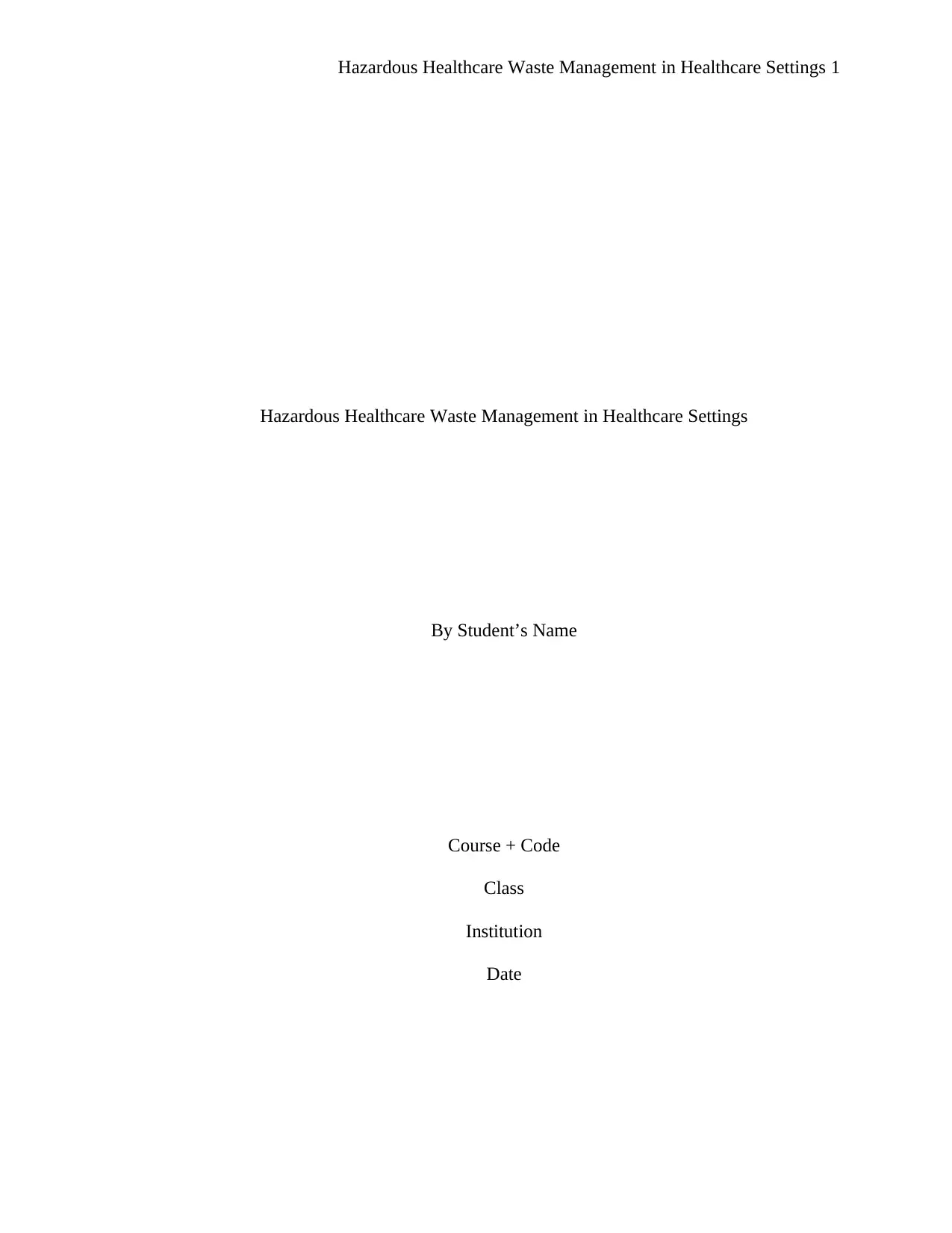
Hazardous Healthcare Waste Management in Healthcare Settings 1
Hazardous Healthcare Waste Management in Healthcare Settings
By Student’s Name
Course + Code
Class
Institution
Date
Hazardous Healthcare Waste Management in Healthcare Settings
By Student’s Name
Course + Code
Class
Institution
Date
Secure Best Marks with AI Grader
Need help grading? Try our AI Grader for instant feedback on your assignments.
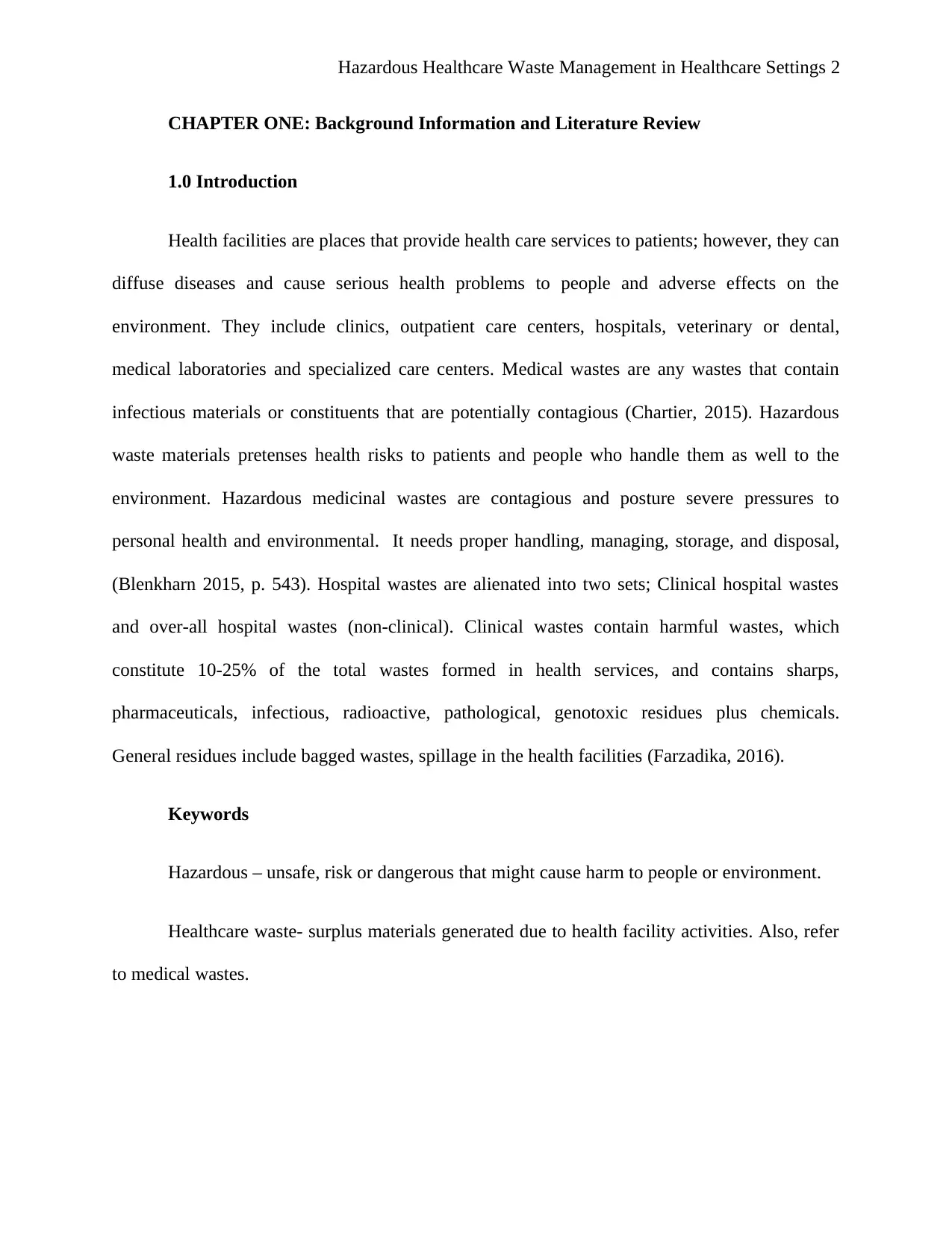
Hazardous Healthcare Waste Management in Healthcare Settings 2
CHAPTER ONE: Background Information and Literature Review
1.0 Introduction
Health facilities are places that provide health care services to patients; however, they can
diffuse diseases and cause serious health problems to people and adverse effects on the
environment. They include clinics, outpatient care centers, hospitals, veterinary or dental,
medical laboratories and specialized care centers. Medical wastes are any wastes that contain
infectious materials or constituents that are potentially contagious (Chartier, 2015). Hazardous
waste materials pretenses health risks to patients and people who handle them as well to the
environment. Hazardous medicinal wastes are contagious and posture severe pressures to
personal health and environmental. It needs proper handling, managing, storage, and disposal,
(Blenkharn 2015, p. 543). Hospital wastes are alienated into two sets; Clinical hospital wastes
and over-all hospital wastes (non-clinical). Clinical wastes contain harmful wastes, which
constitute 10-25% of the total wastes formed in health services, and contains sharps,
pharmaceuticals, infectious, radioactive, pathological, genotoxic residues plus chemicals.
General residues include bagged wastes, spillage in the health facilities (Farzadika, 2016).
Keywords
Hazardous – unsafe, risk or dangerous that might cause harm to people or environment.
Healthcare waste- surplus materials generated due to health facility activities. Also, refer
to medical wastes.
CHAPTER ONE: Background Information and Literature Review
1.0 Introduction
Health facilities are places that provide health care services to patients; however, they can
diffuse diseases and cause serious health problems to people and adverse effects on the
environment. They include clinics, outpatient care centers, hospitals, veterinary or dental,
medical laboratories and specialized care centers. Medical wastes are any wastes that contain
infectious materials or constituents that are potentially contagious (Chartier, 2015). Hazardous
waste materials pretenses health risks to patients and people who handle them as well to the
environment. Hazardous medicinal wastes are contagious and posture severe pressures to
personal health and environmental. It needs proper handling, managing, storage, and disposal,
(Blenkharn 2015, p. 543). Hospital wastes are alienated into two sets; Clinical hospital wastes
and over-all hospital wastes (non-clinical). Clinical wastes contain harmful wastes, which
constitute 10-25% of the total wastes formed in health services, and contains sharps,
pharmaceuticals, infectious, radioactive, pathological, genotoxic residues plus chemicals.
General residues include bagged wastes, spillage in the health facilities (Farzadika, 2016).
Keywords
Hazardous – unsafe, risk or dangerous that might cause harm to people or environment.
Healthcare waste- surplus materials generated due to health facility activities. Also, refer
to medical wastes.
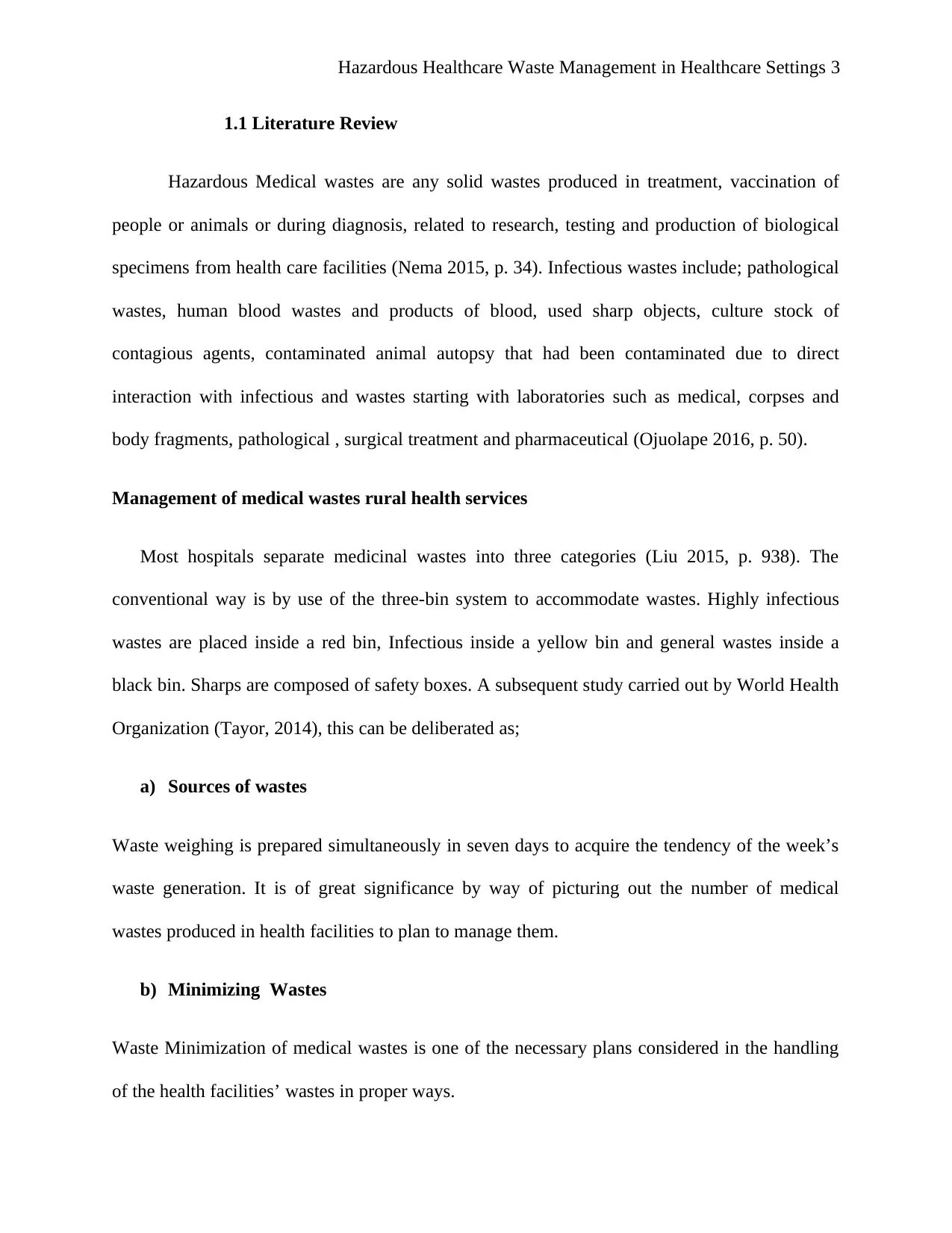
Hazardous Healthcare Waste Management in Healthcare Settings 3
1.1 Literature Review
Hazardous Medical wastes are any solid wastes produced in treatment, vaccination of
people or animals or during diagnosis, related to research, testing and production of biological
specimens from health care facilities (Nema 2015, p. 34). Infectious wastes include; pathological
wastes, human blood wastes and products of blood, used sharp objects, culture stock of
contagious agents, contaminated animal autopsy that had been contaminated due to direct
interaction with infectious and wastes starting with laboratories such as medical, corpses and
body fragments, pathological , surgical treatment and pharmaceutical (Ojuolape 2016, p. 50).
Management of medical wastes rural health services
Most hospitals separate medicinal wastes into three categories (Liu 2015, p. 938). The
conventional way is by use of the three-bin system to accommodate wastes. Highly infectious
wastes are placed inside a red bin, Infectious inside a yellow bin and general wastes inside a
black bin. Sharps are composed of safety boxes. A subsequent study carried out by World Health
Organization (Tayor, 2014), this can be deliberated as;
a) Sources of wastes
Waste weighing is prepared simultaneously in seven days to acquire the tendency of the week’s
waste generation. It is of great significance by way of picturing out the number of medical
wastes produced in health facilities to plan to manage them.
b) Minimizing Wastes
Waste Minimization of medical wastes is one of the necessary plans considered in the handling
of the health facilities’ wastes in proper ways.
1.1 Literature Review
Hazardous Medical wastes are any solid wastes produced in treatment, vaccination of
people or animals or during diagnosis, related to research, testing and production of biological
specimens from health care facilities (Nema 2015, p. 34). Infectious wastes include; pathological
wastes, human blood wastes and products of blood, used sharp objects, culture stock of
contagious agents, contaminated animal autopsy that had been contaminated due to direct
interaction with infectious and wastes starting with laboratories such as medical, corpses and
body fragments, pathological , surgical treatment and pharmaceutical (Ojuolape 2016, p. 50).
Management of medical wastes rural health services
Most hospitals separate medicinal wastes into three categories (Liu 2015, p. 938). The
conventional way is by use of the three-bin system to accommodate wastes. Highly infectious
wastes are placed inside a red bin, Infectious inside a yellow bin and general wastes inside a
black bin. Sharps are composed of safety boxes. A subsequent study carried out by World Health
Organization (Tayor, 2014), this can be deliberated as;
a) Sources of wastes
Waste weighing is prepared simultaneously in seven days to acquire the tendency of the week’s
waste generation. It is of great significance by way of picturing out the number of medical
wastes produced in health facilities to plan to manage them.
b) Minimizing Wastes
Waste Minimization of medical wastes is one of the necessary plans considered in the handling
of the health facilities’ wastes in proper ways.
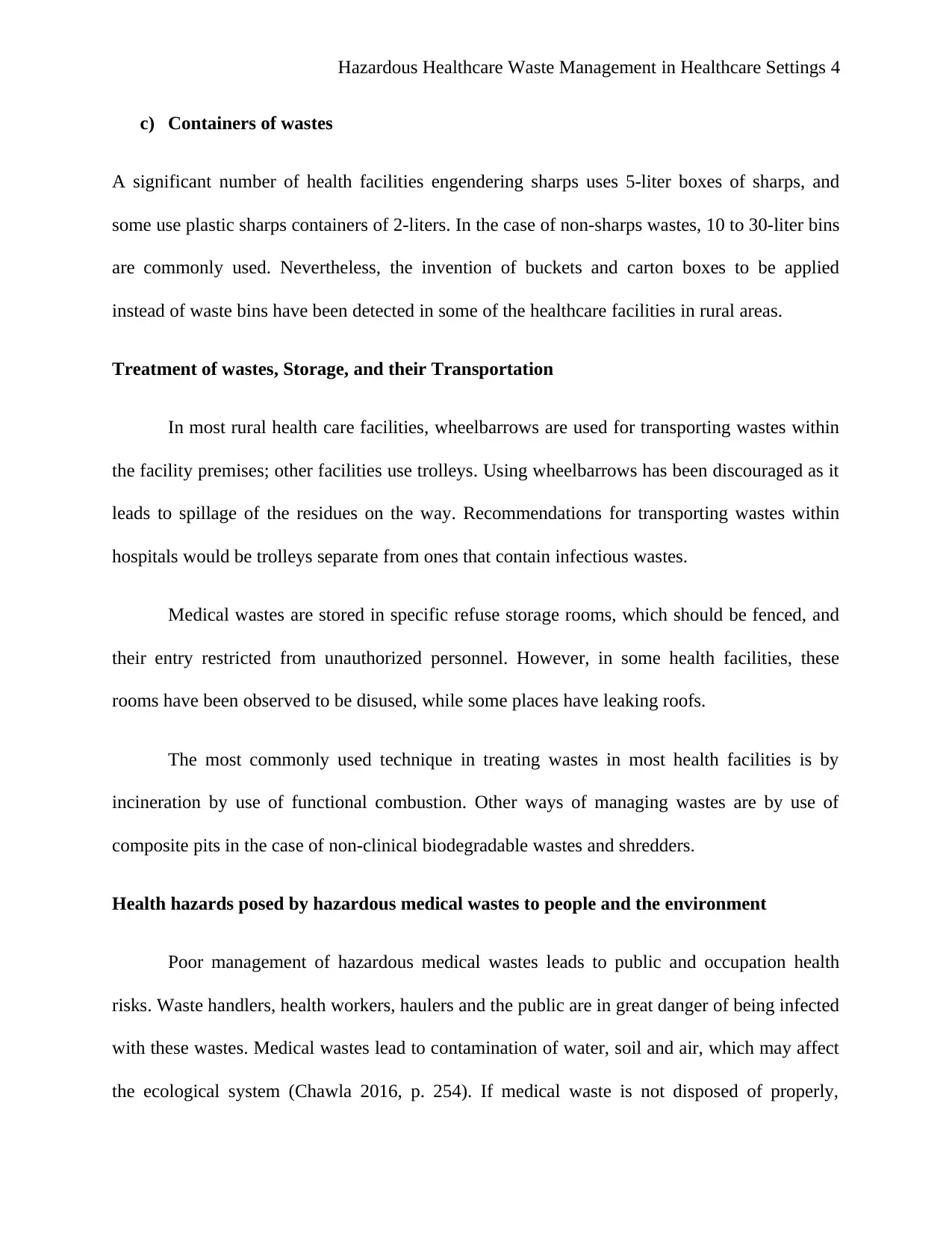
Hazardous Healthcare Waste Management in Healthcare Settings 4
c) Containers of wastes
A significant number of health facilities engendering sharps uses 5-liter boxes of sharps, and
some use plastic sharps containers of 2-liters. In the case of non-sharps wastes, 10 to 30-liter bins
are commonly used. Nevertheless, the invention of buckets and carton boxes to be applied
instead of waste bins have been detected in some of the healthcare facilities in rural areas.
Treatment of wastes, Storage, and their Transportation
In most rural health care facilities, wheelbarrows are used for transporting wastes within
the facility premises; other facilities use trolleys. Using wheelbarrows has been discouraged as it
leads to spillage of the residues on the way. Recommendations for transporting wastes within
hospitals would be trolleys separate from ones that contain infectious wastes.
Medical wastes are stored in specific refuse storage rooms, which should be fenced, and
their entry restricted from unauthorized personnel. However, in some health facilities, these
rooms have been observed to be disused, while some places have leaking roofs.
The most commonly used technique in treating wastes in most health facilities is by
incineration by use of functional combustion. Other ways of managing wastes are by use of
composite pits in the case of non-clinical biodegradable wastes and shredders.
Health hazards posed by hazardous medical wastes to people and the environment
Poor management of hazardous medical wastes leads to public and occupation health
risks. Waste handlers, health workers, haulers and the public are in great danger of being infected
with these wastes. Medical wastes lead to contamination of water, soil and air, which may affect
the ecological system (Chawla 2016, p. 254). If medical waste is not disposed of properly,
c) Containers of wastes
A significant number of health facilities engendering sharps uses 5-liter boxes of sharps, and
some use plastic sharps containers of 2-liters. In the case of non-sharps wastes, 10 to 30-liter bins
are commonly used. Nevertheless, the invention of buckets and carton boxes to be applied
instead of waste bins have been detected in some of the healthcare facilities in rural areas.
Treatment of wastes, Storage, and their Transportation
In most rural health care facilities, wheelbarrows are used for transporting wastes within
the facility premises; other facilities use trolleys. Using wheelbarrows has been discouraged as it
leads to spillage of the residues on the way. Recommendations for transporting wastes within
hospitals would be trolleys separate from ones that contain infectious wastes.
Medical wastes are stored in specific refuse storage rooms, which should be fenced, and
their entry restricted from unauthorized personnel. However, in some health facilities, these
rooms have been observed to be disused, while some places have leaking roofs.
The most commonly used technique in treating wastes in most health facilities is by
incineration by use of functional combustion. Other ways of managing wastes are by use of
composite pits in the case of non-clinical biodegradable wastes and shredders.
Health hazards posed by hazardous medical wastes to people and the environment
Poor management of hazardous medical wastes leads to public and occupation health
risks. Waste handlers, health workers, haulers and the public are in great danger of being infected
with these wastes. Medical wastes lead to contamination of water, soil and air, which may affect
the ecological system (Chawla 2016, p. 254). If medical waste is not disposed of properly,
Secure Best Marks with AI Grader
Need help grading? Try our AI Grader for instant feedback on your assignments.
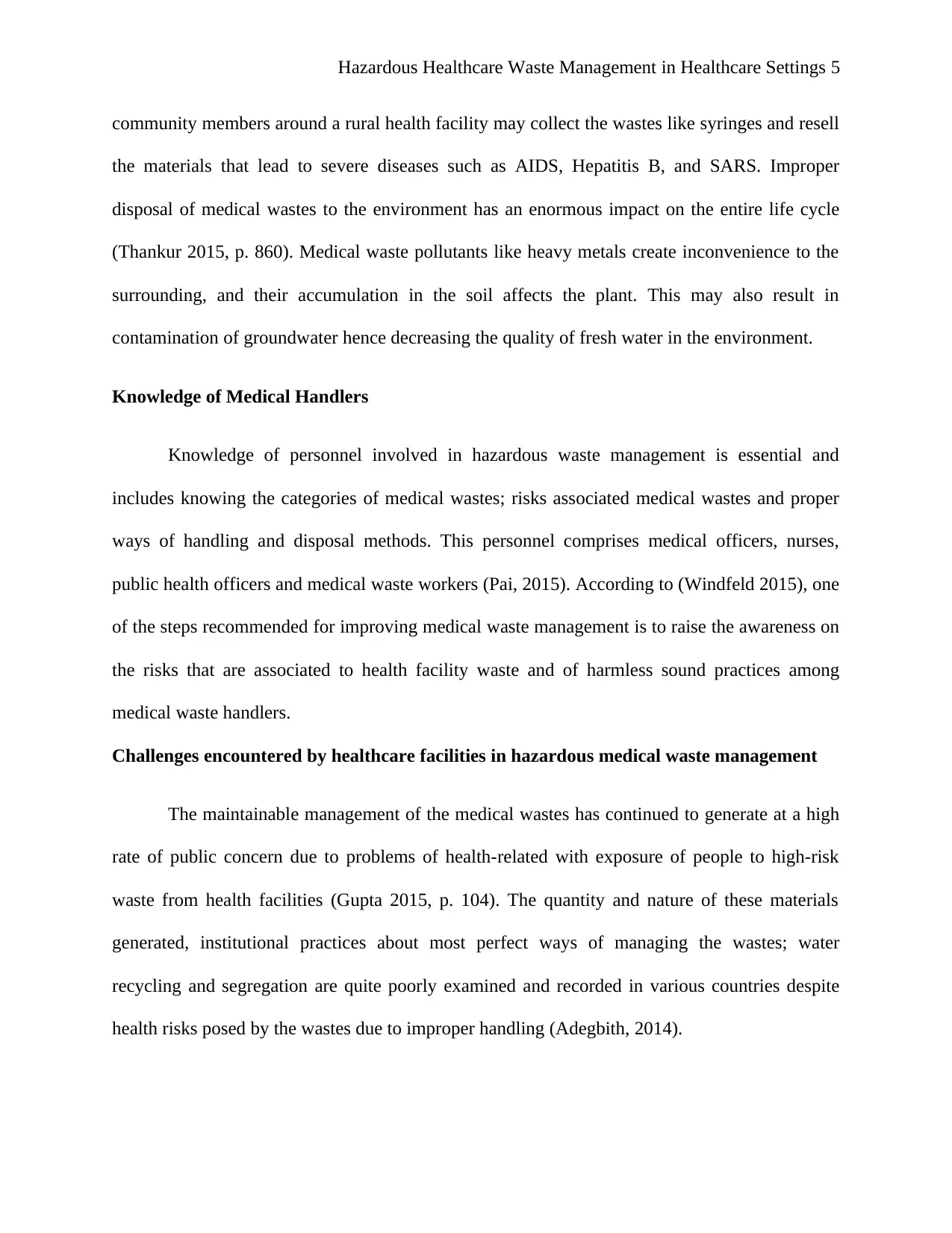
Hazardous Healthcare Waste Management in Healthcare Settings 5
community members around a rural health facility may collect the wastes like syringes and resell
the materials that lead to severe diseases such as AIDS, Hepatitis B, and SARS. Improper
disposal of medical wastes to the environment has an enormous impact on the entire life cycle
(Thankur 2015, p. 860). Medical waste pollutants like heavy metals create inconvenience to the
surrounding, and their accumulation in the soil affects the plant. This may also result in
contamination of groundwater hence decreasing the quality of fresh water in the environment.
Knowledge of Medical Handlers
Knowledge of personnel involved in hazardous waste management is essential and
includes knowing the categories of medical wastes; risks associated medical wastes and proper
ways of handling and disposal methods. This personnel comprises medical officers, nurses,
public health officers and medical waste workers (Pai, 2015). According to (Windfeld 2015), one
of the steps recommended for improving medical waste management is to raise the awareness on
the risks that are associated to health facility waste and of harmless sound practices among
medical waste handlers.
Challenges encountered by healthcare facilities in hazardous medical waste management
The maintainable management of the medical wastes has continued to generate at a high
rate of public concern due to problems of health-related with exposure of people to high-risk
waste from health facilities (Gupta 2015, p. 104). The quantity and nature of these materials
generated, institutional practices about most perfect ways of managing the wastes; water
recycling and segregation are quite poorly examined and recorded in various countries despite
health risks posed by the wastes due to improper handling (Adegbith, 2014).
community members around a rural health facility may collect the wastes like syringes and resell
the materials that lead to severe diseases such as AIDS, Hepatitis B, and SARS. Improper
disposal of medical wastes to the environment has an enormous impact on the entire life cycle
(Thankur 2015, p. 860). Medical waste pollutants like heavy metals create inconvenience to the
surrounding, and their accumulation in the soil affects the plant. This may also result in
contamination of groundwater hence decreasing the quality of fresh water in the environment.
Knowledge of Medical Handlers
Knowledge of personnel involved in hazardous waste management is essential and
includes knowing the categories of medical wastes; risks associated medical wastes and proper
ways of handling and disposal methods. This personnel comprises medical officers, nurses,
public health officers and medical waste workers (Pai, 2015). According to (Windfeld 2015), one
of the steps recommended for improving medical waste management is to raise the awareness on
the risks that are associated to health facility waste and of harmless sound practices among
medical waste handlers.
Challenges encountered by healthcare facilities in hazardous medical waste management
The maintainable management of the medical wastes has continued to generate at a high
rate of public concern due to problems of health-related with exposure of people to high-risk
waste from health facilities (Gupta 2015, p. 104). The quantity and nature of these materials
generated, institutional practices about most perfect ways of managing the wastes; water
recycling and segregation are quite poorly examined and recorded in various countries despite
health risks posed by the wastes due to improper handling (Adegbith, 2014).
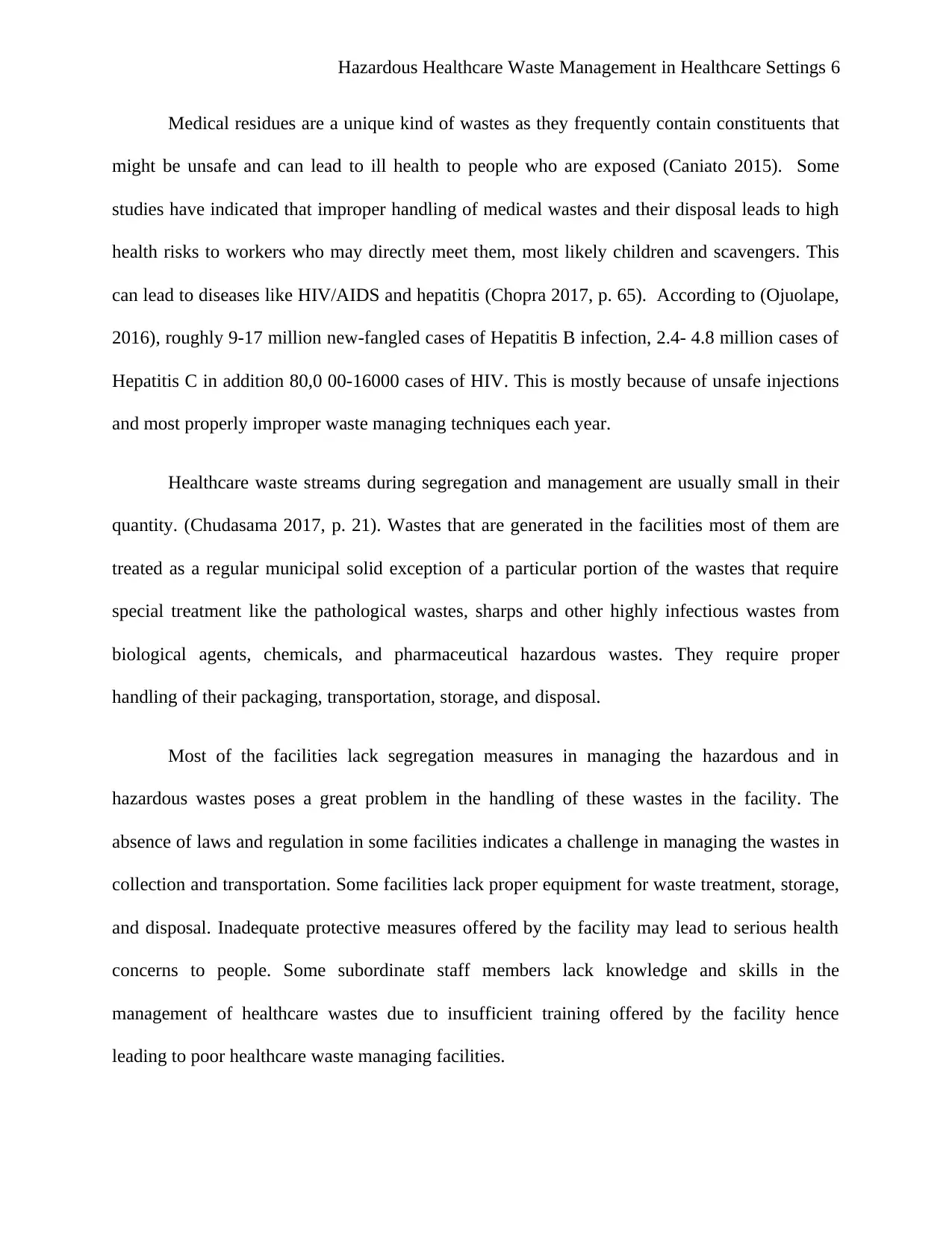
Hazardous Healthcare Waste Management in Healthcare Settings 6
Medical residues are a unique kind of wastes as they frequently contain constituents that
might be unsafe and can lead to ill health to people who are exposed (Caniato 2015). Some
studies have indicated that improper handling of medical wastes and their disposal leads to high
health risks to workers who may directly meet them, most likely children and scavengers. This
can lead to diseases like HIV/AIDS and hepatitis (Chopra 2017, p. 65). According to (Ojuolape,
2016), roughly 9-17 million new-fangled cases of Hepatitis B infection, 2.4- 4.8 million cases of
Hepatitis C in addition 80,0 00-16000 cases of HIV. This is mostly because of unsafe injections
and most properly improper waste managing techniques each year.
Healthcare waste streams during segregation and management are usually small in their
quantity. (Chudasama 2017, p. 21). Wastes that are generated in the facilities most of them are
treated as a regular municipal solid exception of a particular portion of the wastes that require
special treatment like the pathological wastes, sharps and other highly infectious wastes from
biological agents, chemicals, and pharmaceutical hazardous wastes. They require proper
handling of their packaging, transportation, storage, and disposal.
Most of the facilities lack segregation measures in managing the hazardous and in
hazardous wastes poses a great problem in the handling of these wastes in the facility. The
absence of laws and regulation in some facilities indicates a challenge in managing the wastes in
collection and transportation. Some facilities lack proper equipment for waste treatment, storage,
and disposal. Inadequate protective measures offered by the facility may lead to serious health
concerns to people. Some subordinate staff members lack knowledge and skills in the
management of healthcare wastes due to insufficient training offered by the facility hence
leading to poor healthcare waste managing facilities.
Medical residues are a unique kind of wastes as they frequently contain constituents that
might be unsafe and can lead to ill health to people who are exposed (Caniato 2015). Some
studies have indicated that improper handling of medical wastes and their disposal leads to high
health risks to workers who may directly meet them, most likely children and scavengers. This
can lead to diseases like HIV/AIDS and hepatitis (Chopra 2017, p. 65). According to (Ojuolape,
2016), roughly 9-17 million new-fangled cases of Hepatitis B infection, 2.4- 4.8 million cases of
Hepatitis C in addition 80,0 00-16000 cases of HIV. This is mostly because of unsafe injections
and most properly improper waste managing techniques each year.
Healthcare waste streams during segregation and management are usually small in their
quantity. (Chudasama 2017, p. 21). Wastes that are generated in the facilities most of them are
treated as a regular municipal solid exception of a particular portion of the wastes that require
special treatment like the pathological wastes, sharps and other highly infectious wastes from
biological agents, chemicals, and pharmaceutical hazardous wastes. They require proper
handling of their packaging, transportation, storage, and disposal.
Most of the facilities lack segregation measures in managing the hazardous and in
hazardous wastes poses a great problem in the handling of these wastes in the facility. The
absence of laws and regulation in some facilities indicates a challenge in managing the wastes in
collection and transportation. Some facilities lack proper equipment for waste treatment, storage,
and disposal. Inadequate protective measures offered by the facility may lead to serious health
concerns to people. Some subordinate staff members lack knowledge and skills in the
management of healthcare wastes due to insufficient training offered by the facility hence
leading to poor healthcare waste managing facilities.
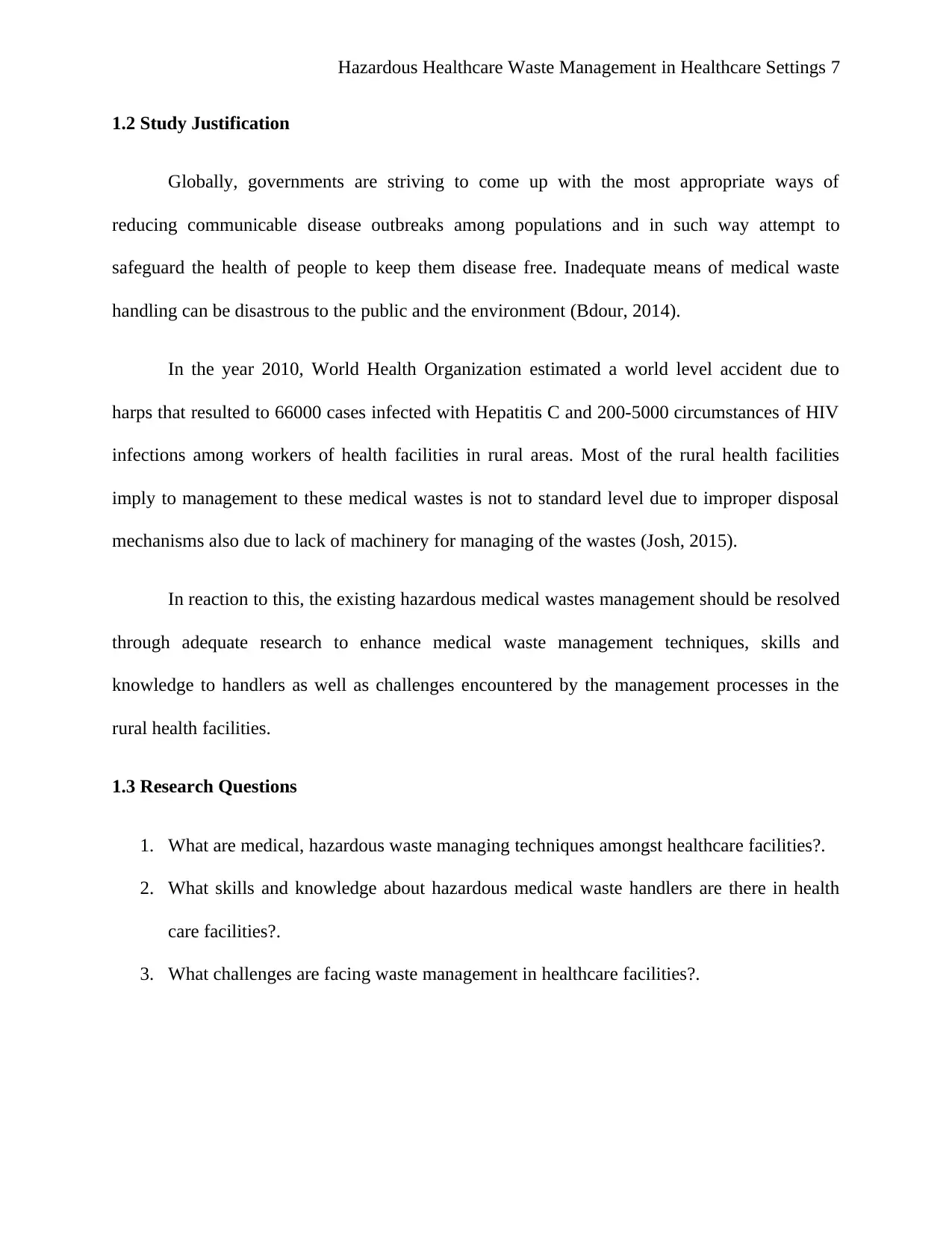
Hazardous Healthcare Waste Management in Healthcare Settings 7
1.2 Study Justification
Globally, governments are striving to come up with the most appropriate ways of
reducing communicable disease outbreaks among populations and in such way attempt to
safeguard the health of people to keep them disease free. Inadequate means of medical waste
handling can be disastrous to the public and the environment (Bdour, 2014).
In the year 2010, World Health Organization estimated a world level accident due to
harps that resulted to 66000 cases infected with Hepatitis C and 200-5000 circumstances of HIV
infections among workers of health facilities in rural areas. Most of the rural health facilities
imply to management to these medical wastes is not to standard level due to improper disposal
mechanisms also due to lack of machinery for managing of the wastes (Josh, 2015).
In reaction to this, the existing hazardous medical wastes management should be resolved
through adequate research to enhance medical waste management techniques, skills and
knowledge to handlers as well as challenges encountered by the management processes in the
rural health facilities.
1.3 Research Questions
1. What are medical, hazardous waste managing techniques amongst healthcare facilities?.
2. What skills and knowledge about hazardous medical waste handlers are there in health
care facilities?.
3. What challenges are facing waste management in healthcare facilities?.
1.2 Study Justification
Globally, governments are striving to come up with the most appropriate ways of
reducing communicable disease outbreaks among populations and in such way attempt to
safeguard the health of people to keep them disease free. Inadequate means of medical waste
handling can be disastrous to the public and the environment (Bdour, 2014).
In the year 2010, World Health Organization estimated a world level accident due to
harps that resulted to 66000 cases infected with Hepatitis C and 200-5000 circumstances of HIV
infections among workers of health facilities in rural areas. Most of the rural health facilities
imply to management to these medical wastes is not to standard level due to improper disposal
mechanisms also due to lack of machinery for managing of the wastes (Josh, 2015).
In reaction to this, the existing hazardous medical wastes management should be resolved
through adequate research to enhance medical waste management techniques, skills and
knowledge to handlers as well as challenges encountered by the management processes in the
rural health facilities.
1.3 Research Questions
1. What are medical, hazardous waste managing techniques amongst healthcare facilities?.
2. What skills and knowledge about hazardous medical waste handlers are there in health
care facilities?.
3. What challenges are facing waste management in healthcare facilities?.
Paraphrase This Document
Need a fresh take? Get an instant paraphrase of this document with our AI Paraphraser
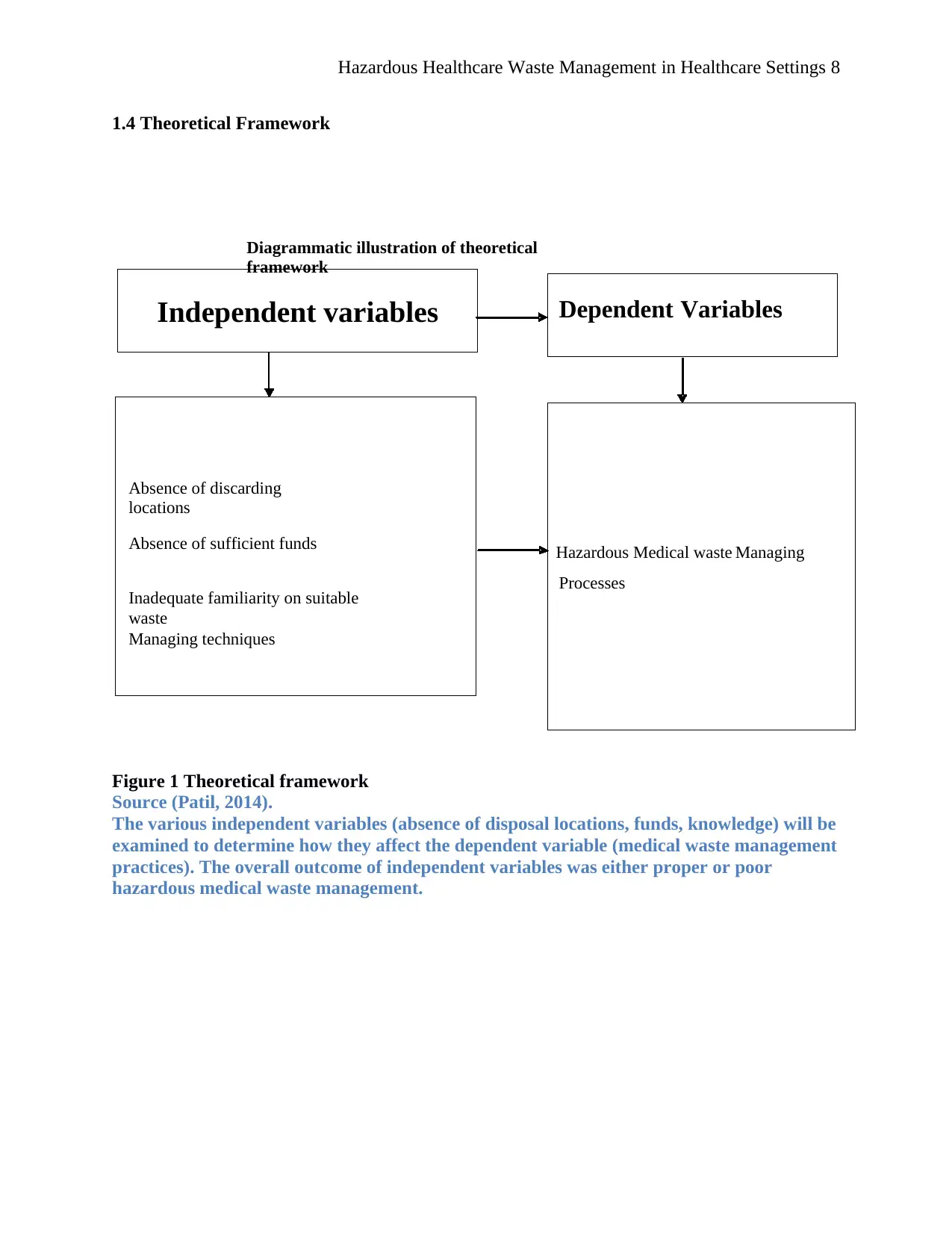
Diagrammatic illustration of theoretical
framework
Independent variables Dependent Variables
Absence of discarding
locations
Absence of sufficient funds
Inadequate familiarity on suitable
waste
Managing techniques
Hazardous Medical waste Managing
Processes
Figure 1 Theoretical framework
Source (Patil, 2014).
The various independent variables (absence of disposal locations, funds, knowledge) will be
examined to determine how they affect the dependent variable (medical waste management
practices). The overall outcome of independent variables was either proper or poor
hazardous medical waste management.
Hazardous Healthcare Waste Management in Healthcare Settings 8
1.4 Theoretical Framework
framework
Independent variables Dependent Variables
Absence of discarding
locations
Absence of sufficient funds
Inadequate familiarity on suitable
waste
Managing techniques
Hazardous Medical waste Managing
Processes
Figure 1 Theoretical framework
Source (Patil, 2014).
The various independent variables (absence of disposal locations, funds, knowledge) will be
examined to determine how they affect the dependent variable (medical waste management
practices). The overall outcome of independent variables was either proper or poor
hazardous medical waste management.
Hazardous Healthcare Waste Management in Healthcare Settings 8
1.4 Theoretical Framework
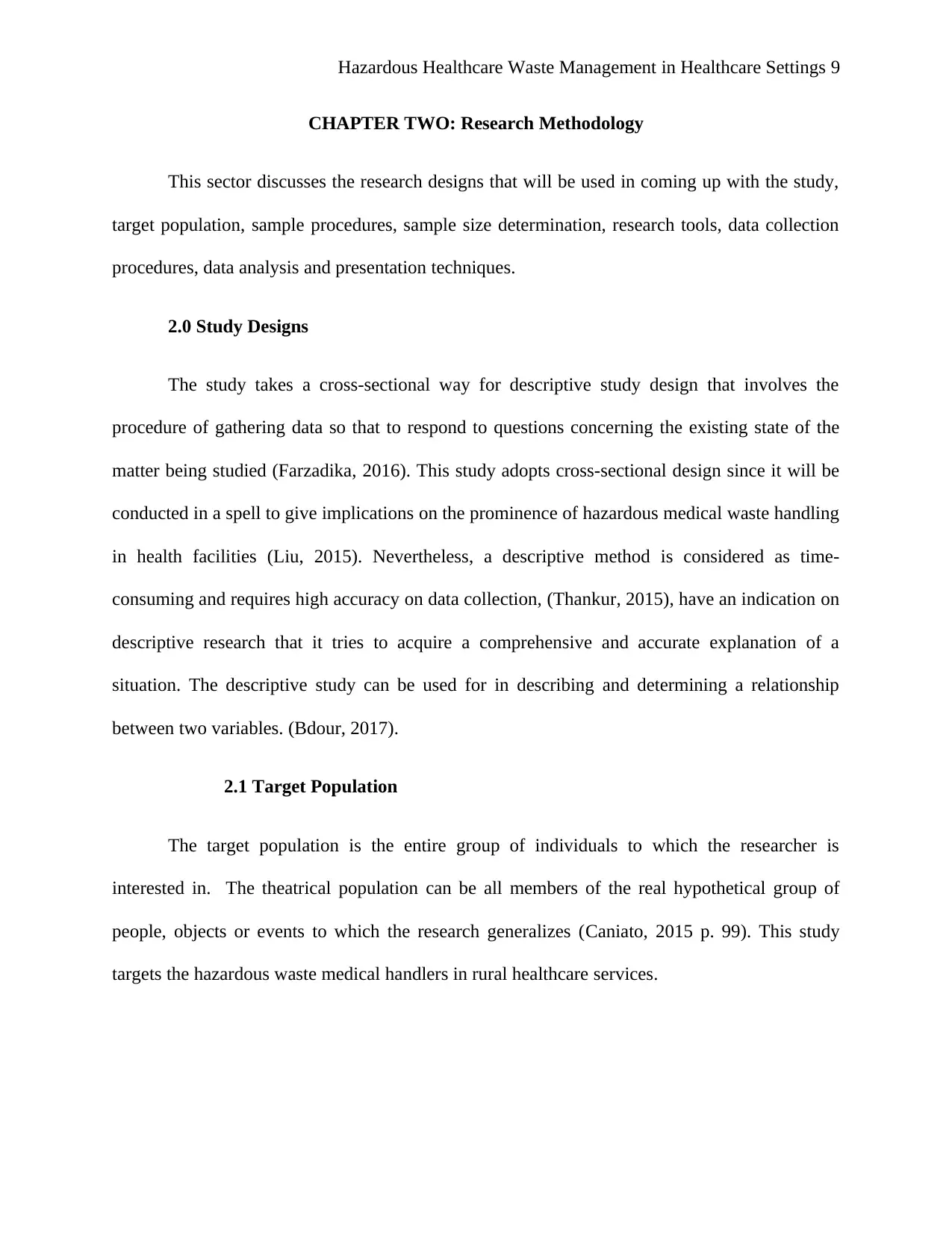
Hazardous Healthcare Waste Management in Healthcare Settings 9
CHAPTER TWO: Research Methodology
This sector discusses the research designs that will be used in coming up with the study,
target population, sample procedures, sample size determination, research tools, data collection
procedures, data analysis and presentation techniques.
2.0 Study Designs
The study takes a cross-sectional way for descriptive study design that involves the
procedure of gathering data so that to respond to questions concerning the existing state of the
matter being studied (Farzadika, 2016). This study adopts cross-sectional design since it will be
conducted in a spell to give implications on the prominence of hazardous medical waste handling
in health facilities (Liu, 2015). Nevertheless, a descriptive method is considered as time-
consuming and requires high accuracy on data collection, (Thankur, 2015), have an indication on
descriptive research that it tries to acquire a comprehensive and accurate explanation of a
situation. The descriptive study can be used for in describing and determining a relationship
between two variables. (Bdour, 2017).
2.1 Target Population
The target population is the entire group of individuals to which the researcher is
interested in. The theatrical population can be all members of the real hypothetical group of
people, objects or events to which the research generalizes (Caniato, 2015 p. 99). This study
targets the hazardous waste medical handlers in rural healthcare services.
CHAPTER TWO: Research Methodology
This sector discusses the research designs that will be used in coming up with the study,
target population, sample procedures, sample size determination, research tools, data collection
procedures, data analysis and presentation techniques.
2.0 Study Designs
The study takes a cross-sectional way for descriptive study design that involves the
procedure of gathering data so that to respond to questions concerning the existing state of the
matter being studied (Farzadika, 2016). This study adopts cross-sectional design since it will be
conducted in a spell to give implications on the prominence of hazardous medical waste handling
in health facilities (Liu, 2015). Nevertheless, a descriptive method is considered as time-
consuming and requires high accuracy on data collection, (Thankur, 2015), have an indication on
descriptive research that it tries to acquire a comprehensive and accurate explanation of a
situation. The descriptive study can be used for in describing and determining a relationship
between two variables. (Bdour, 2017).
2.1 Target Population
The target population is the entire group of individuals to which the researcher is
interested in. The theatrical population can be all members of the real hypothetical group of
people, objects or events to which the research generalizes (Caniato, 2015 p. 99). This study
targets the hazardous waste medical handlers in rural healthcare services.
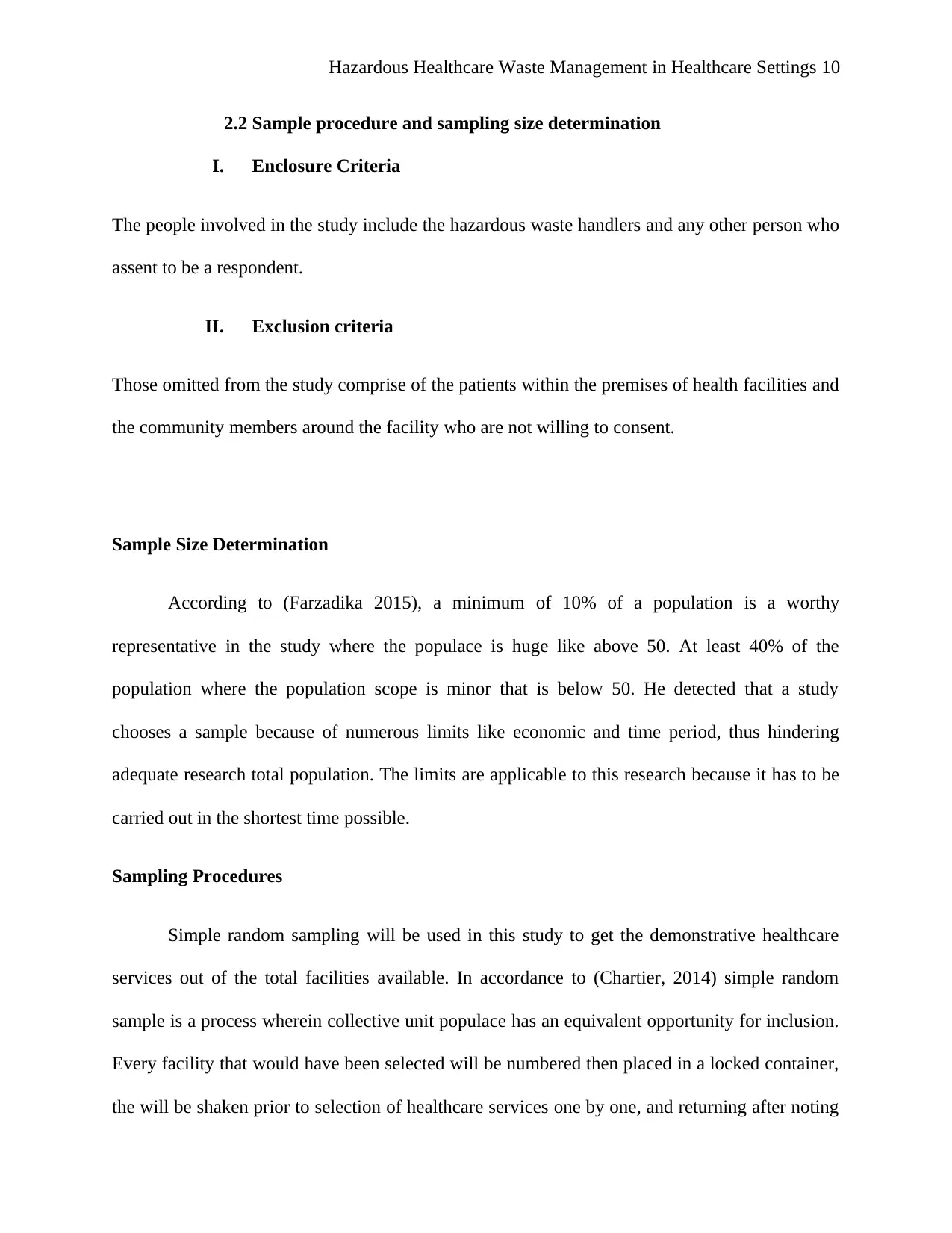
Hazardous Healthcare Waste Management in Healthcare Settings 10
2.2 Sample procedure and sampling size determination
I. Enclosure Criteria
The people involved in the study include the hazardous waste handlers and any other person who
assent to be a respondent.
II. Exclusion criteria
Those omitted from the study comprise of the patients within the premises of health facilities and
the community members around the facility who are not willing to consent.
Sample Size Determination
According to (Farzadika 2015), a minimum of 10% of a population is a worthy
representative in the study where the populace is huge like above 50. At least 40% of the
population where the population scope is minor that is below 50. He detected that a study
chooses a sample because of numerous limits like economic and time period, thus hindering
adequate research total population. The limits are applicable to this research because it has to be
carried out in the shortest time possible.
Sampling Procedures
Simple random sampling will be used in this study to get the demonstrative healthcare
services out of the total facilities available. In accordance to (Chartier, 2014) simple random
sample is a process wherein collective unit populace has an equivalent opportunity for inclusion.
Every facility that would have been selected will be numbered then placed in a locked container,
the will be shaken prior to selection of healthcare services one by one, and returning after noting
2.2 Sample procedure and sampling size determination
I. Enclosure Criteria
The people involved in the study include the hazardous waste handlers and any other person who
assent to be a respondent.
II. Exclusion criteria
Those omitted from the study comprise of the patients within the premises of health facilities and
the community members around the facility who are not willing to consent.
Sample Size Determination
According to (Farzadika 2015), a minimum of 10% of a population is a worthy
representative in the study where the populace is huge like above 50. At least 40% of the
population where the population scope is minor that is below 50. He detected that a study
chooses a sample because of numerous limits like economic and time period, thus hindering
adequate research total population. The limits are applicable to this research because it has to be
carried out in the shortest time possible.
Sampling Procedures
Simple random sampling will be used in this study to get the demonstrative healthcare
services out of the total facilities available. In accordance to (Chartier, 2014) simple random
sample is a process wherein collective unit populace has an equivalent opportunity for inclusion.
Every facility that would have been selected will be numbered then placed in a locked container,
the will be shaken prior to selection of healthcare services one by one, and returning after noting
Secure Best Marks with AI Grader
Need help grading? Try our AI Grader for instant feedback on your assignments.
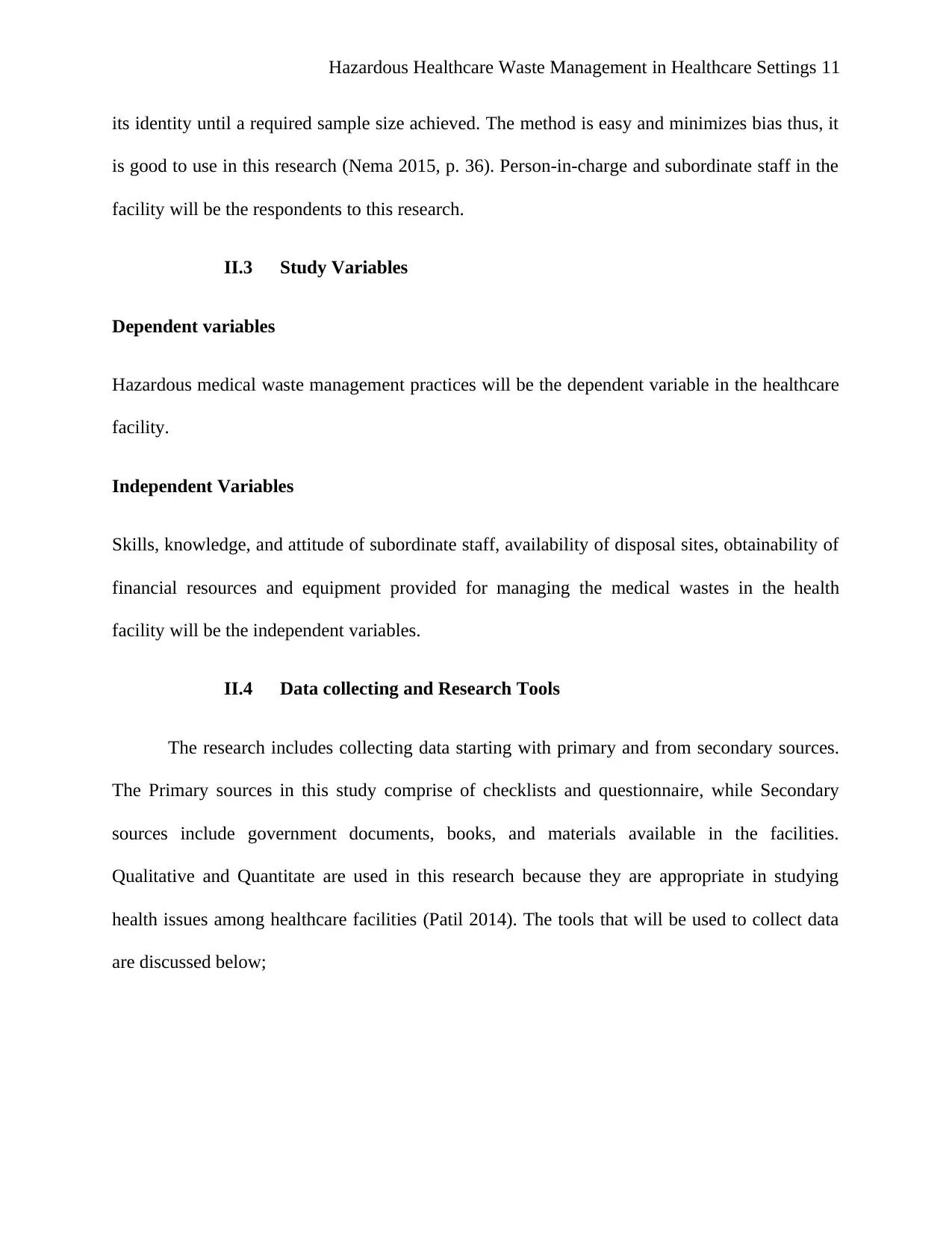
Hazardous Healthcare Waste Management in Healthcare Settings 11
its identity until a required sample size achieved. The method is easy and minimizes bias thus, it
is good to use in this research (Nema 2015, p. 36). Person-in-charge and subordinate staff in the
facility will be the respondents to this research.
II.3 Study Variables
Dependent variables
Hazardous medical waste management practices will be the dependent variable in the healthcare
facility.
Independent Variables
Skills, knowledge, and attitude of subordinate staff, availability of disposal sites, obtainability of
financial resources and equipment provided for managing the medical wastes in the health
facility will be the independent variables.
II.4 Data collecting and Research Tools
The research includes collecting data starting with primary and from secondary sources.
The Primary sources in this study comprise of checklists and questionnaire, while Secondary
sources include government documents, books, and materials available in the facilities.
Qualitative and Quantitate are used in this research because they are appropriate in studying
health issues among healthcare facilities (Patil 2014). The tools that will be used to collect data
are discussed below;
its identity until a required sample size achieved. The method is easy and minimizes bias thus, it
is good to use in this research (Nema 2015, p. 36). Person-in-charge and subordinate staff in the
facility will be the respondents to this research.
II.3 Study Variables
Dependent variables
Hazardous medical waste management practices will be the dependent variable in the healthcare
facility.
Independent Variables
Skills, knowledge, and attitude of subordinate staff, availability of disposal sites, obtainability of
financial resources and equipment provided for managing the medical wastes in the health
facility will be the independent variables.
II.4 Data collecting and Research Tools
The research includes collecting data starting with primary and from secondary sources.
The Primary sources in this study comprise of checklists and questionnaire, while Secondary
sources include government documents, books, and materials available in the facilities.
Qualitative and Quantitate are used in this research because they are appropriate in studying
health issues among healthcare facilities (Patil 2014). The tools that will be used to collect data
are discussed below;
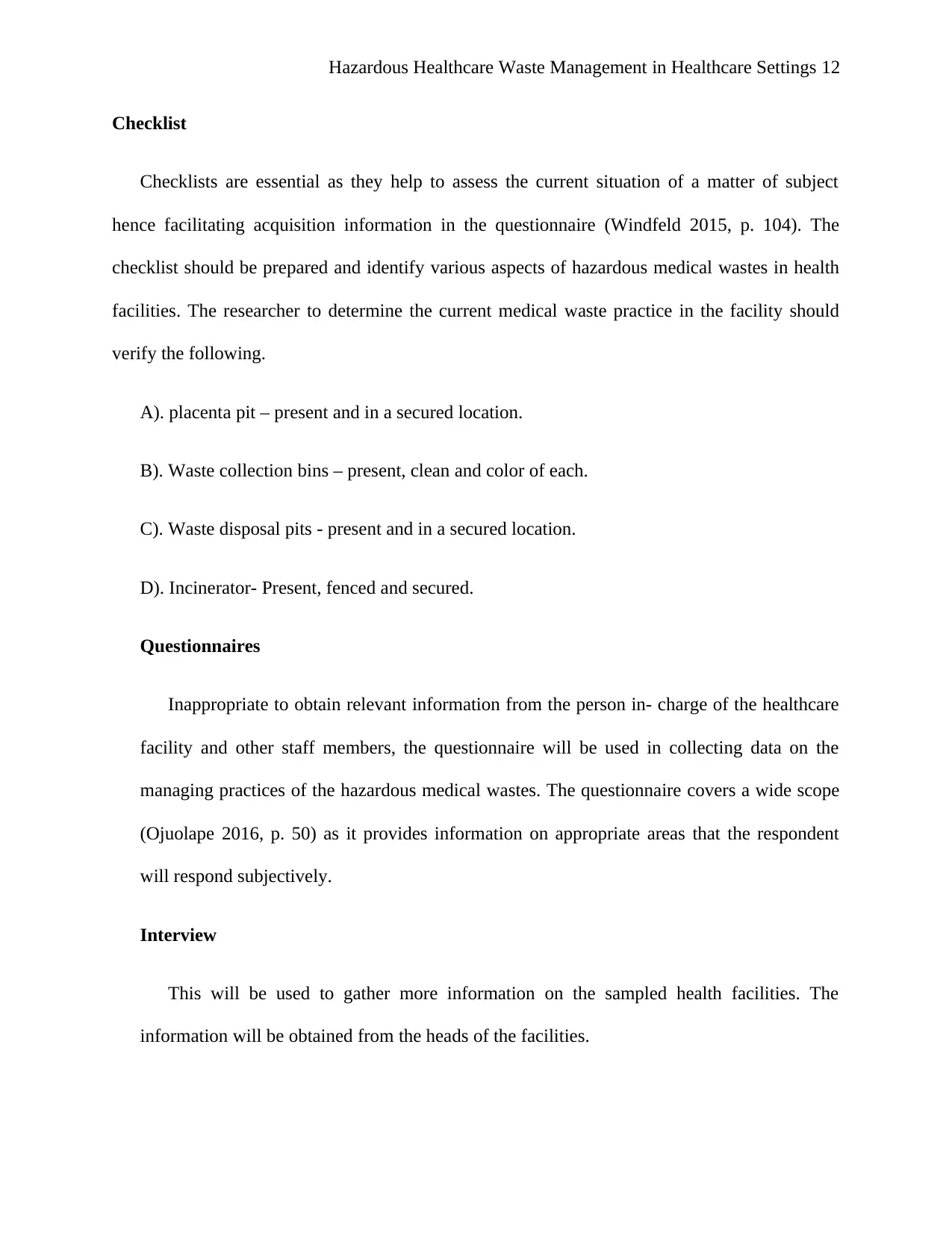
Hazardous Healthcare Waste Management in Healthcare Settings 12
Checklist
Checklists are essential as they help to assess the current situation of a matter of subject
hence facilitating acquisition information in the questionnaire (Windfeld 2015, p. 104). The
checklist should be prepared and identify various aspects of hazardous medical wastes in health
facilities. The researcher to determine the current medical waste practice in the facility should
verify the following.
A). placenta pit – present and in a secured location.
B). Waste collection bins – present, clean and color of each.
C). Waste disposal pits - present and in a secured location.
D). Incinerator- Present, fenced and secured.
Questionnaires
Inappropriate to obtain relevant information from the person in- charge of the healthcare
facility and other staff members, the questionnaire will be used in collecting data on the
managing practices of the hazardous medical wastes. The questionnaire covers a wide scope
(Ojuolape 2016, p. 50) as it provides information on appropriate areas that the respondent
will respond subjectively.
Interview
This will be used to gather more information on the sampled health facilities. The
information will be obtained from the heads of the facilities.
Checklist
Checklists are essential as they help to assess the current situation of a matter of subject
hence facilitating acquisition information in the questionnaire (Windfeld 2015, p. 104). The
checklist should be prepared and identify various aspects of hazardous medical wastes in health
facilities. The researcher to determine the current medical waste practice in the facility should
verify the following.
A). placenta pit – present and in a secured location.
B). Waste collection bins – present, clean and color of each.
C). Waste disposal pits - present and in a secured location.
D). Incinerator- Present, fenced and secured.
Questionnaires
Inappropriate to obtain relevant information from the person in- charge of the healthcare
facility and other staff members, the questionnaire will be used in collecting data on the
managing practices of the hazardous medical wastes. The questionnaire covers a wide scope
(Ojuolape 2016, p. 50) as it provides information on appropriate areas that the respondent
will respond subjectively.
Interview
This will be used to gather more information on the sampled health facilities. The
information will be obtained from the heads of the facilities.
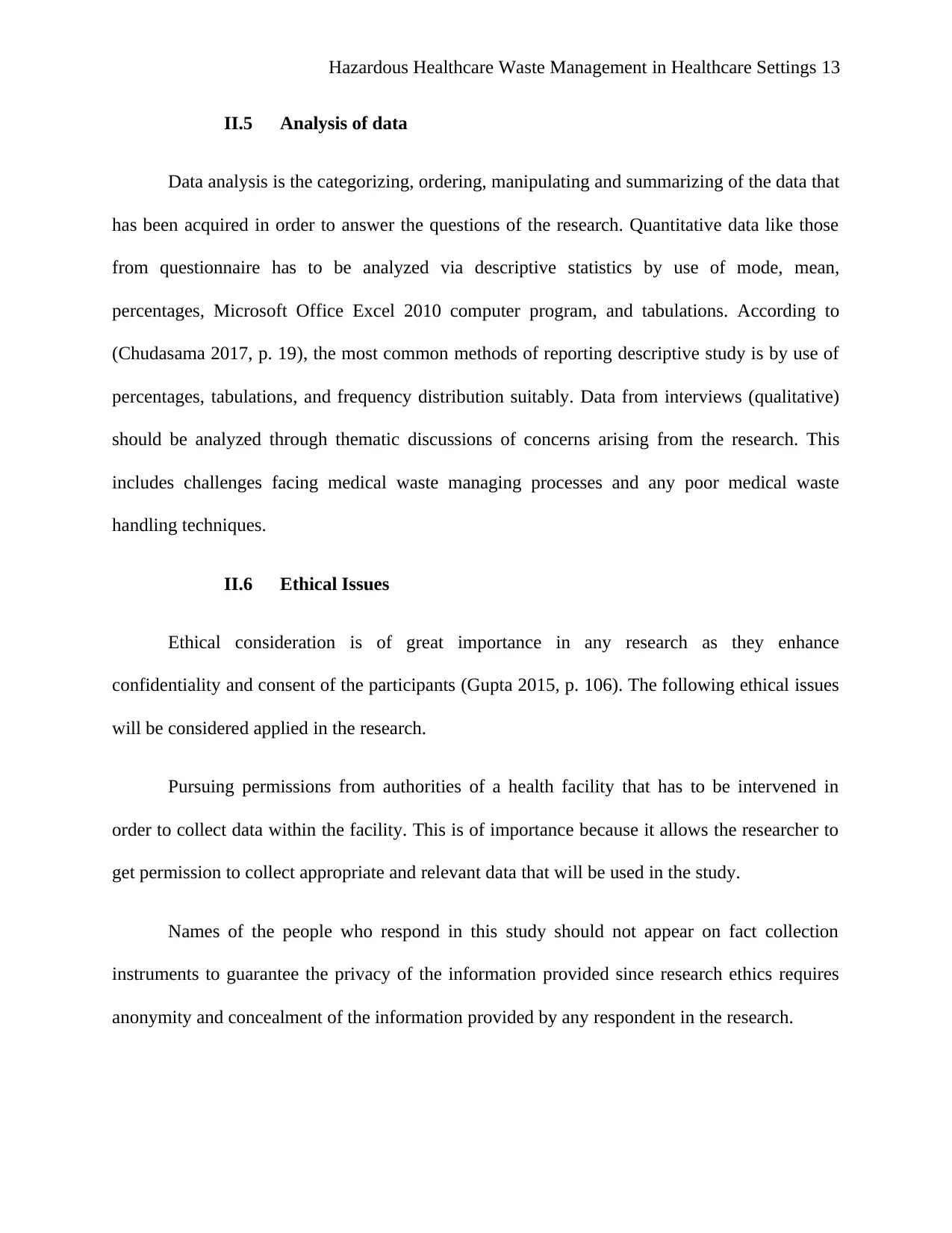
Hazardous Healthcare Waste Management in Healthcare Settings 13
II.5 Analysis of data
Data analysis is the categorizing, ordering, manipulating and summarizing of the data that
has been acquired in order to answer the questions of the research. Quantitative data like those
from questionnaire has to be analyzed via descriptive statistics by use of mode, mean,
percentages, Microsoft Office Excel 2010 computer program, and tabulations. According to
(Chudasama 2017, p. 19), the most common methods of reporting descriptive study is by use of
percentages, tabulations, and frequency distribution suitably. Data from interviews (qualitative)
should be analyzed through thematic discussions of concerns arising from the research. This
includes challenges facing medical waste managing processes and any poor medical waste
handling techniques.
II.6 Ethical Issues
Ethical consideration is of great importance in any research as they enhance
confidentiality and consent of the participants (Gupta 2015, p. 106). The following ethical issues
will be considered applied in the research.
Pursuing permissions from authorities of a health facility that has to be intervened in
order to collect data within the facility. This is of importance because it allows the researcher to
get permission to collect appropriate and relevant data that will be used in the study.
Names of the people who respond in this study should not appear on fact collection
instruments to guarantee the privacy of the information provided since research ethics requires
anonymity and concealment of the information provided by any respondent in the research.
II.5 Analysis of data
Data analysis is the categorizing, ordering, manipulating and summarizing of the data that
has been acquired in order to answer the questions of the research. Quantitative data like those
from questionnaire has to be analyzed via descriptive statistics by use of mode, mean,
percentages, Microsoft Office Excel 2010 computer program, and tabulations. According to
(Chudasama 2017, p. 19), the most common methods of reporting descriptive study is by use of
percentages, tabulations, and frequency distribution suitably. Data from interviews (qualitative)
should be analyzed through thematic discussions of concerns arising from the research. This
includes challenges facing medical waste managing processes and any poor medical waste
handling techniques.
II.6 Ethical Issues
Ethical consideration is of great importance in any research as they enhance
confidentiality and consent of the participants (Gupta 2015, p. 106). The following ethical issues
will be considered applied in the research.
Pursuing permissions from authorities of a health facility that has to be intervened in
order to collect data within the facility. This is of importance because it allows the researcher to
get permission to collect appropriate and relevant data that will be used in the study.
Names of the people who respond in this study should not appear on fact collection
instruments to guarantee the privacy of the information provided since research ethics requires
anonymity and concealment of the information provided by any respondent in the research.
Paraphrase This Document
Need a fresh take? Get an instant paraphrase of this document with our AI Paraphraser
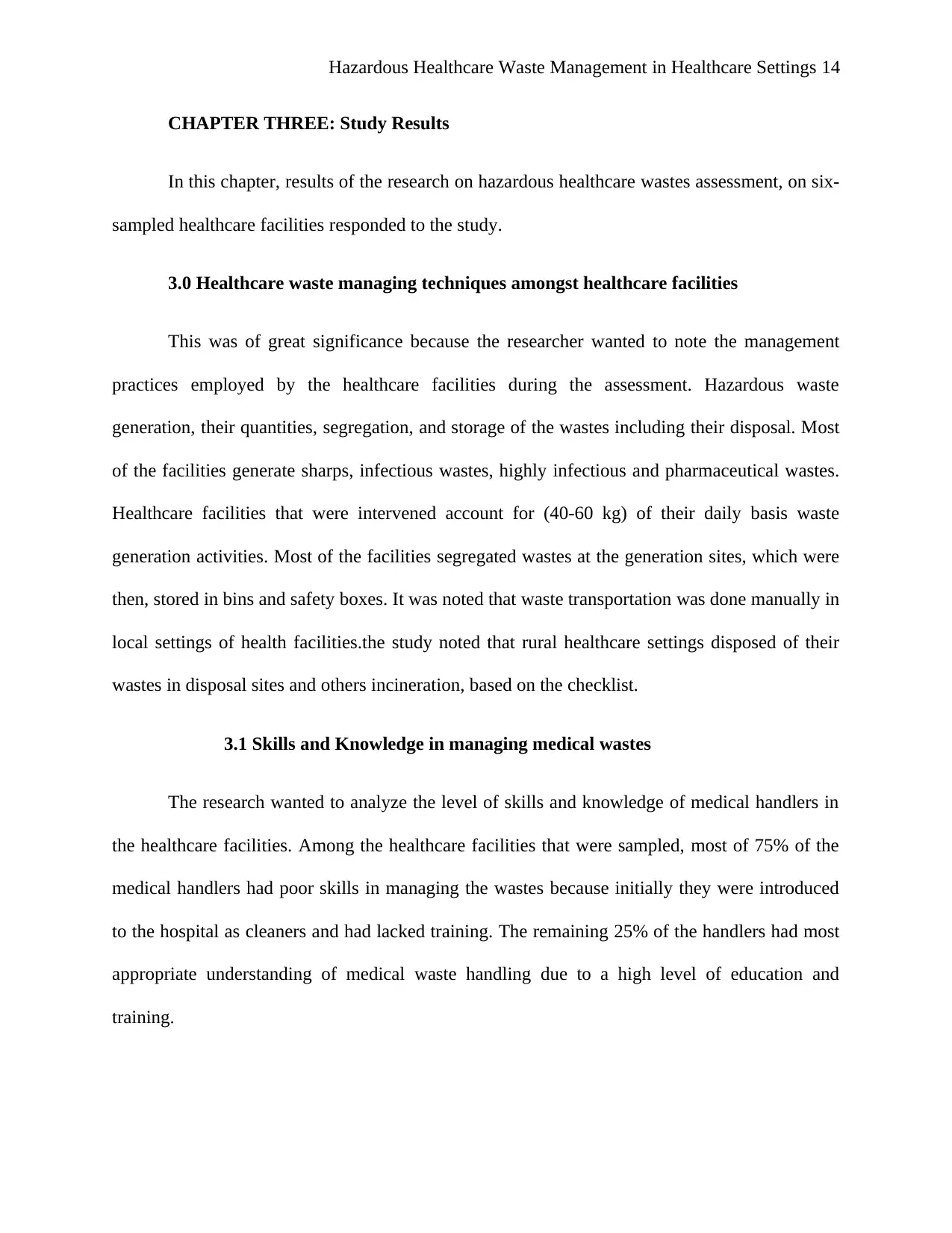
Hazardous Healthcare Waste Management in Healthcare Settings 14
CHAPTER THREE: Study Results
In this chapter, results of the research on hazardous healthcare wastes assessment, on six-
sampled healthcare facilities responded to the study.
3.0 Healthcare waste managing techniques amongst healthcare facilities
This was of great significance because the researcher wanted to note the management
practices employed by the healthcare facilities during the assessment. Hazardous waste
generation, their quantities, segregation, and storage of the wastes including their disposal. Most
of the facilities generate sharps, infectious wastes, highly infectious and pharmaceutical wastes.
Healthcare facilities that were intervened account for (40-60 kg) of their daily basis waste
generation activities. Most of the facilities segregated wastes at the generation sites, which were
then, stored in bins and safety boxes. It was noted that waste transportation was done manually in
local settings of health facilities.the study noted that rural healthcare settings disposed of their
wastes in disposal sites and others incineration, based on the checklist.
3.1 Skills and Knowledge in managing medical wastes
The research wanted to analyze the level of skills and knowledge of medical handlers in
the healthcare facilities. Among the healthcare facilities that were sampled, most of 75% of the
medical handlers had poor skills in managing the wastes because initially they were introduced
to the hospital as cleaners and had lacked training. The remaining 25% of the handlers had most
appropriate understanding of medical waste handling due to a high level of education and
training.
CHAPTER THREE: Study Results
In this chapter, results of the research on hazardous healthcare wastes assessment, on six-
sampled healthcare facilities responded to the study.
3.0 Healthcare waste managing techniques amongst healthcare facilities
This was of great significance because the researcher wanted to note the management
practices employed by the healthcare facilities during the assessment. Hazardous waste
generation, their quantities, segregation, and storage of the wastes including their disposal. Most
of the facilities generate sharps, infectious wastes, highly infectious and pharmaceutical wastes.
Healthcare facilities that were intervened account for (40-60 kg) of their daily basis waste
generation activities. Most of the facilities segregated wastes at the generation sites, which were
then, stored in bins and safety boxes. It was noted that waste transportation was done manually in
local settings of health facilities.the study noted that rural healthcare settings disposed of their
wastes in disposal sites and others incineration, based on the checklist.
3.1 Skills and Knowledge in managing medical wastes
The research wanted to analyze the level of skills and knowledge of medical handlers in
the healthcare facilities. Among the healthcare facilities that were sampled, most of 75% of the
medical handlers had poor skills in managing the wastes because initially they were introduced
to the hospital as cleaners and had lacked training. The remaining 25% of the handlers had most
appropriate understanding of medical waste handling due to a high level of education and
training.
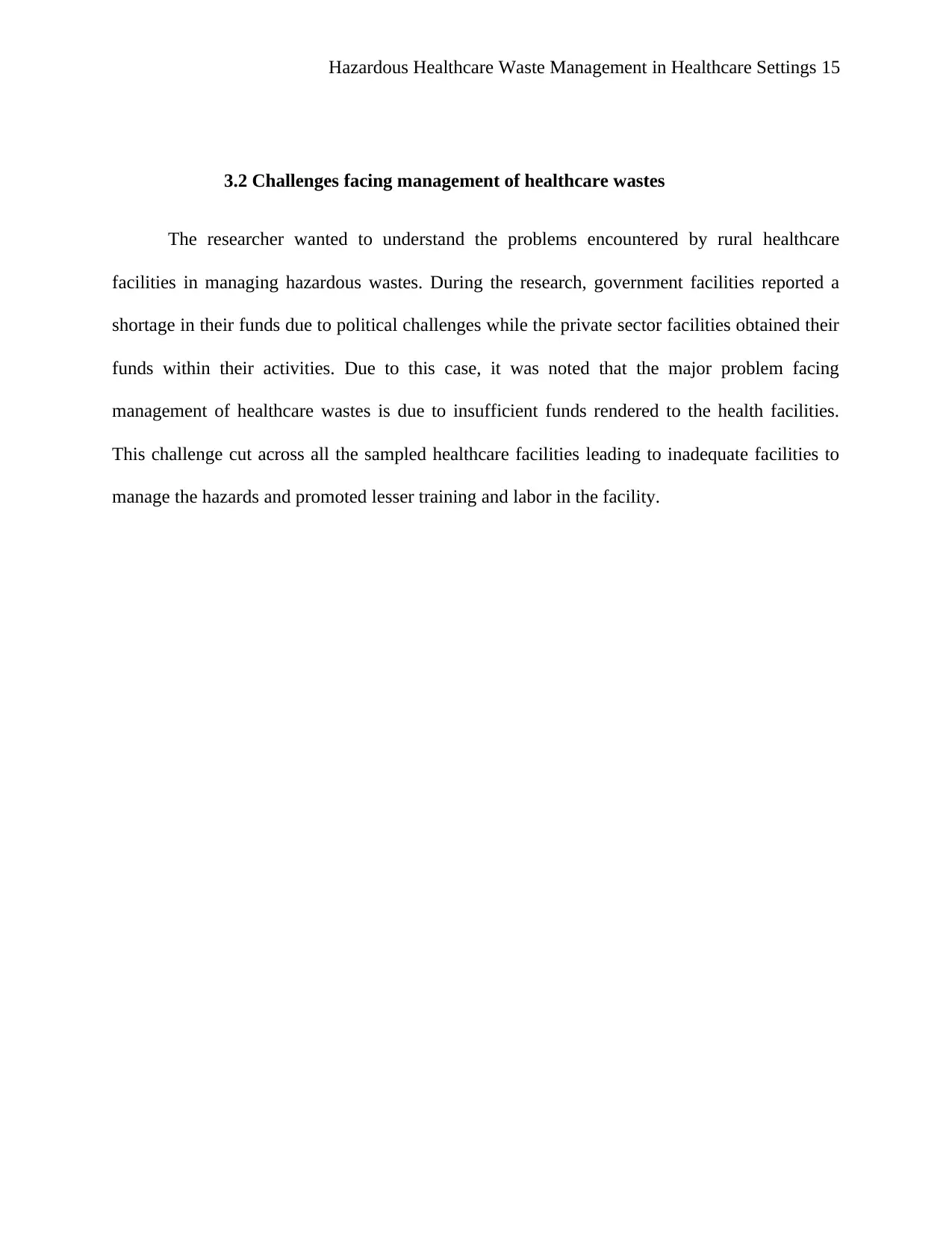
Hazardous Healthcare Waste Management in Healthcare Settings 15
3.2 Challenges facing management of healthcare wastes
The researcher wanted to understand the problems encountered by rural healthcare
facilities in managing hazardous wastes. During the research, government facilities reported a
shortage in their funds due to political challenges while the private sector facilities obtained their
funds within their activities. Due to this case, it was noted that the major problem facing
management of healthcare wastes is due to insufficient funds rendered to the health facilities.
This challenge cut across all the sampled healthcare facilities leading to inadequate facilities to
manage the hazards and promoted lesser training and labor in the facility.
3.2 Challenges facing management of healthcare wastes
The researcher wanted to understand the problems encountered by rural healthcare
facilities in managing hazardous wastes. During the research, government facilities reported a
shortage in their funds due to political challenges while the private sector facilities obtained their
funds within their activities. Due to this case, it was noted that the major problem facing
management of healthcare wastes is due to insufficient funds rendered to the health facilities.
This challenge cut across all the sampled healthcare facilities leading to inadequate facilities to
manage the hazards and promoted lesser training and labor in the facility.
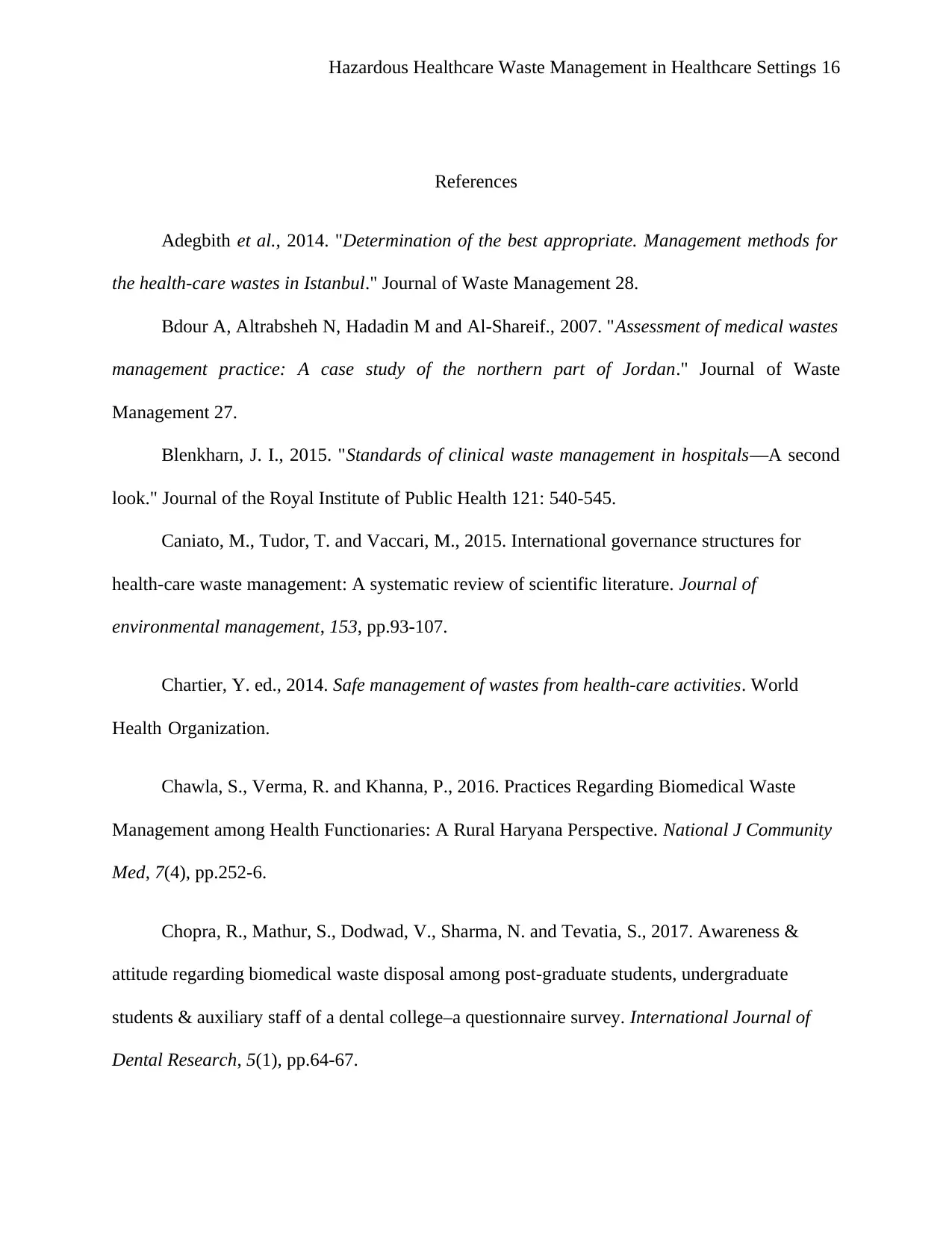
Hazardous Healthcare Waste Management in Healthcare Settings 16
References
Adegbith et al., 2014. "Determination of the best appropriate. Management methods for
the health-care wastes in Istanbul." Journal of Waste Management 28.
Bdour A, Altrabsheh N, Hadadin M and Al-Shareif., 2007. "Assessment of medical wastes
management practice: A case study of the northern part of Jordan." Journal of Waste
Management 27.
Blenkharn, J. I., 2015. "Standards of clinical waste management in hospitals—A second
look." Journal of the Royal Institute of Public Health 121: 540-545.
Caniato, M., Tudor, T. and Vaccari, M., 2015. International governance structures for
health-care waste management: A systematic review of scientific literature. Journal of
environmental management, 153, pp.93-107.
Chartier, Y. ed., 2014. Safe management of wastes from health-care activities. World
Health Organization.
Chawla, S., Verma, R. and Khanna, P., 2016. Practices Regarding Biomedical Waste
Management among Health Functionaries: A Rural Haryana Perspective. National J Community
Med, 7(4), pp.252-6.
Chopra, R., Mathur, S., Dodwad, V., Sharma, N. and Tevatia, S., 2017. Awareness &
attitude regarding biomedical waste disposal among post-graduate students, undergraduate
students & auxiliary staff of a dental college–a questionnaire survey. International Journal of
Dental Research, 5(1), pp.64-67.
References
Adegbith et al., 2014. "Determination of the best appropriate. Management methods for
the health-care wastes in Istanbul." Journal of Waste Management 28.
Bdour A, Altrabsheh N, Hadadin M and Al-Shareif., 2007. "Assessment of medical wastes
management practice: A case study of the northern part of Jordan." Journal of Waste
Management 27.
Blenkharn, J. I., 2015. "Standards of clinical waste management in hospitals—A second
look." Journal of the Royal Institute of Public Health 121: 540-545.
Caniato, M., Tudor, T. and Vaccari, M., 2015. International governance structures for
health-care waste management: A systematic review of scientific literature. Journal of
environmental management, 153, pp.93-107.
Chartier, Y. ed., 2014. Safe management of wastes from health-care activities. World
Health Organization.
Chawla, S., Verma, R. and Khanna, P., 2016. Practices Regarding Biomedical Waste
Management among Health Functionaries: A Rural Haryana Perspective. National J Community
Med, 7(4), pp.252-6.
Chopra, R., Mathur, S., Dodwad, V., Sharma, N. and Tevatia, S., 2017. Awareness &
attitude regarding biomedical waste disposal among post-graduate students, undergraduate
students & auxiliary staff of a dental college–a questionnaire survey. International Journal of
Dental Research, 5(1), pp.64-67.
Secure Best Marks with AI Grader
Need help grading? Try our AI Grader for instant feedback on your assignments.
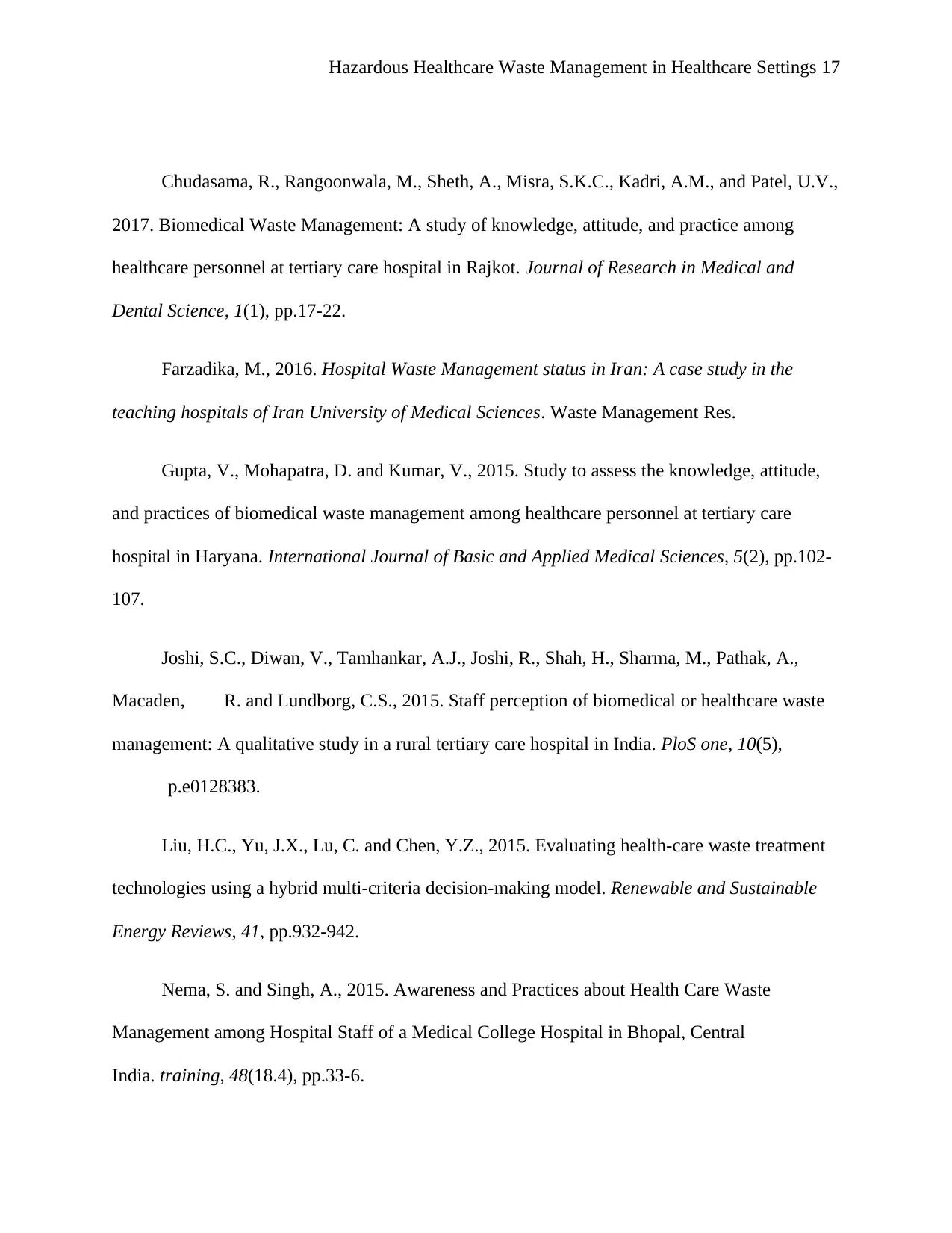
Hazardous Healthcare Waste Management in Healthcare Settings 17
Chudasama, R., Rangoonwala, M., Sheth, A., Misra, S.K.C., Kadri, A.M., and Patel, U.V.,
2017. Biomedical Waste Management: A study of knowledge, attitude, and practice among
healthcare personnel at tertiary care hospital in Rajkot. Journal of Research in Medical and
Dental Science, 1(1), pp.17-22.
Farzadika, M., 2016. Hospital Waste Management status in Iran: A case study in the
teaching hospitals of Iran University of Medical Sciences. Waste Management Res.
Gupta, V., Mohapatra, D. and Kumar, V., 2015. Study to assess the knowledge, attitude,
and practices of biomedical waste management among healthcare personnel at tertiary care
hospital in Haryana. International Journal of Basic and Applied Medical Sciences, 5(2), pp.102-
107.
Joshi, S.C., Diwan, V., Tamhankar, A.J., Joshi, R., Shah, H., Sharma, M., Pathak, A.,
Macaden, R. and Lundborg, C.S., 2015. Staff perception of biomedical or healthcare waste
management: A qualitative study in a rural tertiary care hospital in India. PloS one, 10(5),
p.e0128383.
Liu, H.C., Yu, J.X., Lu, C. and Chen, Y.Z., 2015. Evaluating health-care waste treatment
technologies using a hybrid multi-criteria decision-making model. Renewable and Sustainable
Energy Reviews, 41, pp.932-942.
Nema, S. and Singh, A., 2015. Awareness and Practices about Health Care Waste
Management among Hospital Staff of a Medical College Hospital in Bhopal, Central
India. training, 48(18.4), pp.33-6.
Chudasama, R., Rangoonwala, M., Sheth, A., Misra, S.K.C., Kadri, A.M., and Patel, U.V.,
2017. Biomedical Waste Management: A study of knowledge, attitude, and practice among
healthcare personnel at tertiary care hospital in Rajkot. Journal of Research in Medical and
Dental Science, 1(1), pp.17-22.
Farzadika, M., 2016. Hospital Waste Management status in Iran: A case study in the
teaching hospitals of Iran University of Medical Sciences. Waste Management Res.
Gupta, V., Mohapatra, D. and Kumar, V., 2015. Study to assess the knowledge, attitude,
and practices of biomedical waste management among healthcare personnel at tertiary care
hospital in Haryana. International Journal of Basic and Applied Medical Sciences, 5(2), pp.102-
107.
Joshi, S.C., Diwan, V., Tamhankar, A.J., Joshi, R., Shah, H., Sharma, M., Pathak, A.,
Macaden, R. and Lundborg, C.S., 2015. Staff perception of biomedical or healthcare waste
management: A qualitative study in a rural tertiary care hospital in India. PloS one, 10(5),
p.e0128383.
Liu, H.C., Yu, J.X., Lu, C. and Chen, Y.Z., 2015. Evaluating health-care waste treatment
technologies using a hybrid multi-criteria decision-making model. Renewable and Sustainable
Energy Reviews, 41, pp.932-942.
Nema, S. and Singh, A., 2015. Awareness and Practices about Health Care Waste
Management among Hospital Staff of a Medical College Hospital in Bhopal, Central
India. training, 48(18.4), pp.33-6.
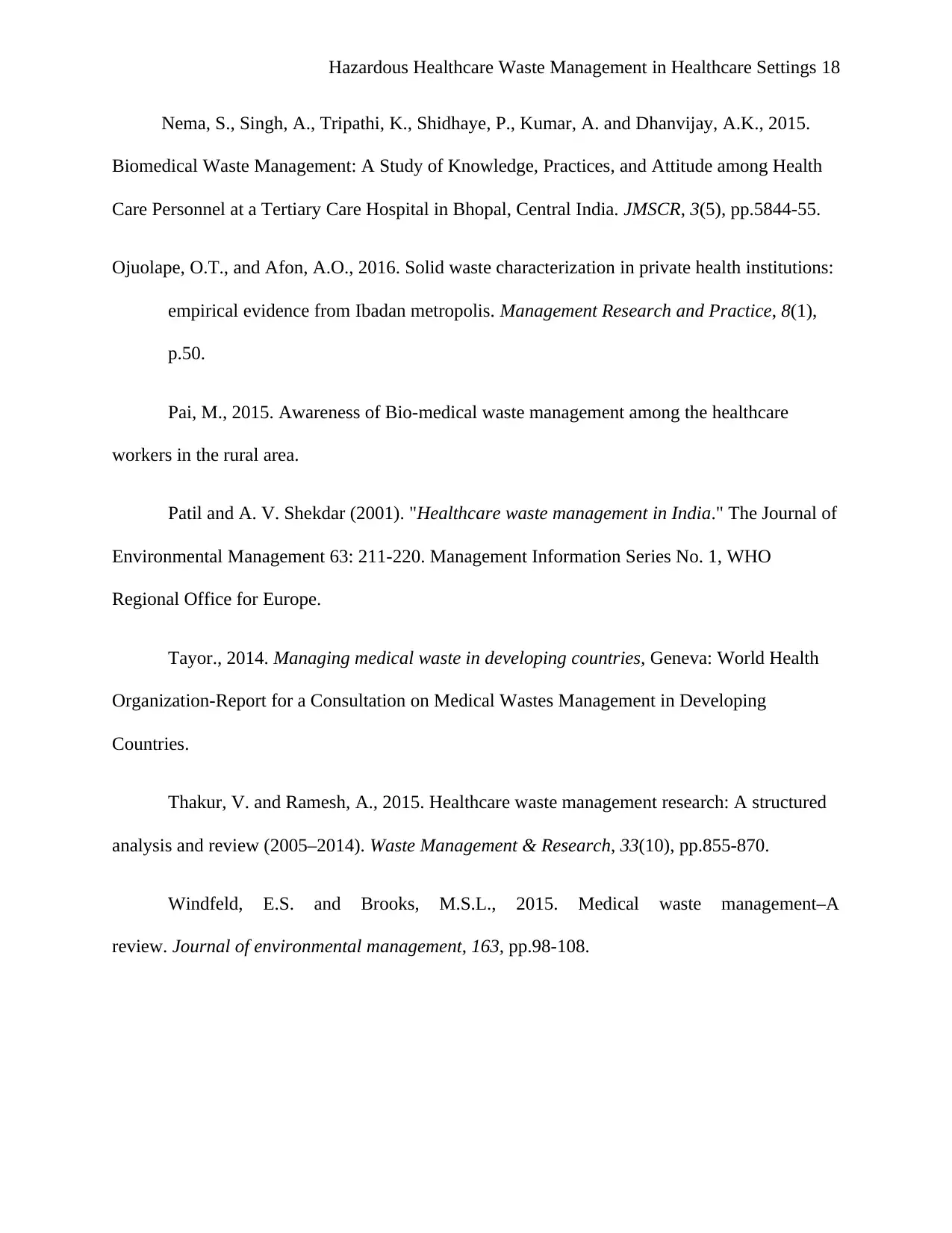
Hazardous Healthcare Waste Management in Healthcare Settings 18
Nema, S., Singh, A., Tripathi, K., Shidhaye, P., Kumar, A. and Dhanvijay, A.K., 2015.
Biomedical Waste Management: A Study of Knowledge, Practices, and Attitude among Health
Care Personnel at a Tertiary Care Hospital in Bhopal, Central India. JMSCR, 3(5), pp.5844-55.
Ojuolape, O.T., and Afon, A.O., 2016. Solid waste characterization in private health institutions:
empirical evidence from Ibadan metropolis. Management Research and Practice, 8(1),
p.50.
Pai, M., 2015. Awareness of Bio-medical waste management among the healthcare
workers in the rural area.
Patil and A. V. Shekdar (2001). "Healthcare waste management in India." The Journal of
Environmental Management 63: 211-220. Management Information Series No. 1, WHO
Regional Office for Europe.
Tayor., 2014. Managing medical waste in developing countries, Geneva: World Health
Organization-Report for a Consultation on Medical Wastes Management in Developing
Countries.
Thakur, V. and Ramesh, A., 2015. Healthcare waste management research: A structured
analysis and review (2005–2014). Waste Management & Research, 33(10), pp.855-870.
Windfeld, E.S. and Brooks, M.S.L., 2015. Medical waste management–A
review. Journal of environmental management, 163, pp.98-108.
Nema, S., Singh, A., Tripathi, K., Shidhaye, P., Kumar, A. and Dhanvijay, A.K., 2015.
Biomedical Waste Management: A Study of Knowledge, Practices, and Attitude among Health
Care Personnel at a Tertiary Care Hospital in Bhopal, Central India. JMSCR, 3(5), pp.5844-55.
Ojuolape, O.T., and Afon, A.O., 2016. Solid waste characterization in private health institutions:
empirical evidence from Ibadan metropolis. Management Research and Practice, 8(1),
p.50.
Pai, M., 2015. Awareness of Bio-medical waste management among the healthcare
workers in the rural area.
Patil and A. V. Shekdar (2001). "Healthcare waste management in India." The Journal of
Environmental Management 63: 211-220. Management Information Series No. 1, WHO
Regional Office for Europe.
Tayor., 2014. Managing medical waste in developing countries, Geneva: World Health
Organization-Report for a Consultation on Medical Wastes Management in Developing
Countries.
Thakur, V. and Ramesh, A., 2015. Healthcare waste management research: A structured
analysis and review (2005–2014). Waste Management & Research, 33(10), pp.855-870.
Windfeld, E.S. and Brooks, M.S.L., 2015. Medical waste management–A
review. Journal of environmental management, 163, pp.98-108.
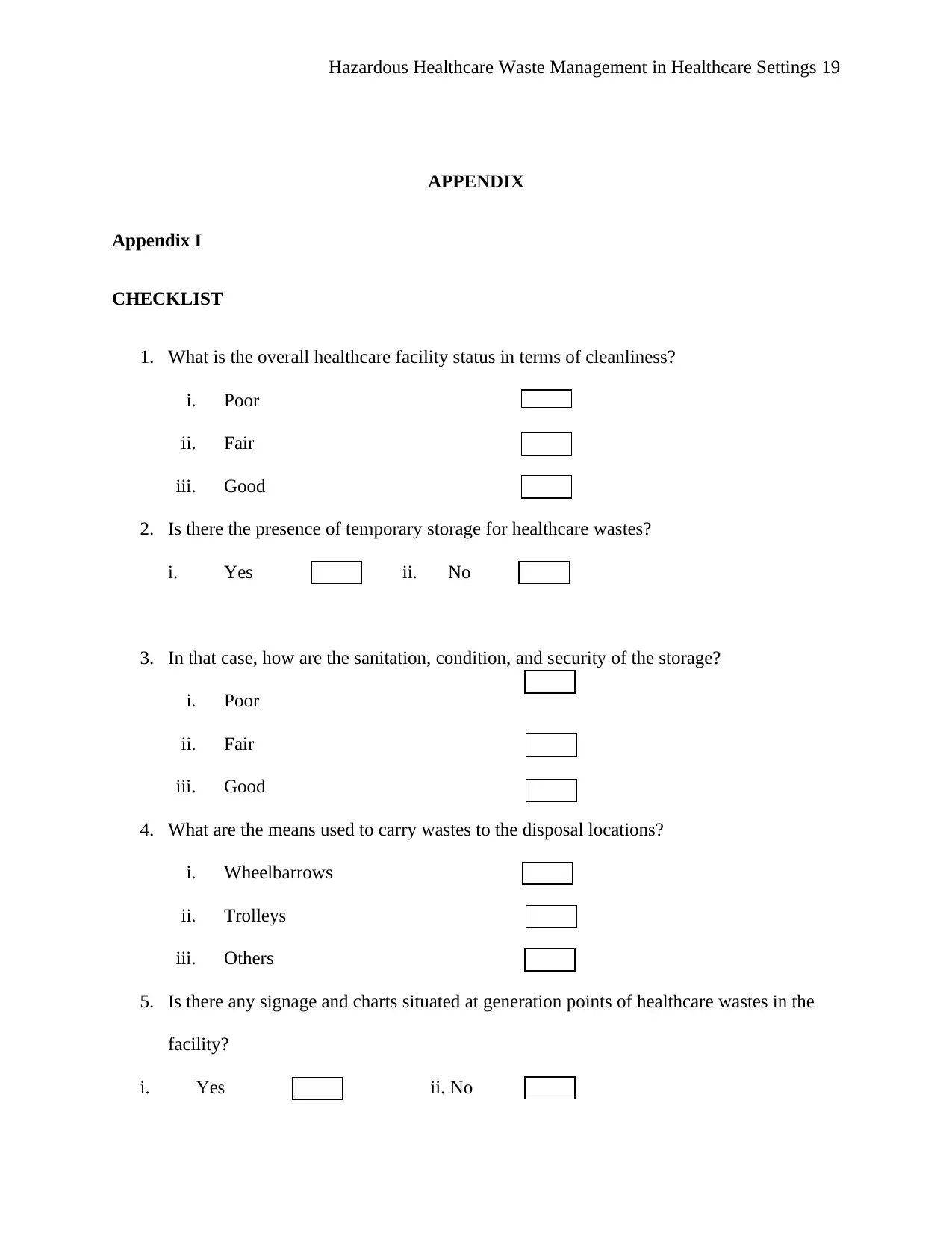
Hazardous Healthcare Waste Management in Healthcare Settings 19
APPENDIX
Appendix I
CHECKLIST
1. What is the overall healthcare facility status in terms of cleanliness?
i. Poor
ii. Fair
iii. Good
2. Is there the presence of temporary storage for healthcare wastes?
i. Yes ii. No
3. In that case, how are the sanitation, condition, and security of the storage?
i. Poor
ii. Fair
iii. Good
4. What are the means used to carry wastes to the disposal locations?
i. Wheelbarrows
ii. Trolleys
iii. Others
5. Is there any signage and charts situated at generation points of healthcare wastes in the
facility?
i. Yes ii. No
APPENDIX
Appendix I
CHECKLIST
1. What is the overall healthcare facility status in terms of cleanliness?
i. Poor
ii. Fair
iii. Good
2. Is there the presence of temporary storage for healthcare wastes?
i. Yes ii. No
3. In that case, how are the sanitation, condition, and security of the storage?
i. Poor
ii. Fair
iii. Good
4. What are the means used to carry wastes to the disposal locations?
i. Wheelbarrows
ii. Trolleys
iii. Others
5. Is there any signage and charts situated at generation points of healthcare wastes in the
facility?
i. Yes ii. No
Paraphrase This Document
Need a fresh take? Get an instant paraphrase of this document with our AI Paraphraser
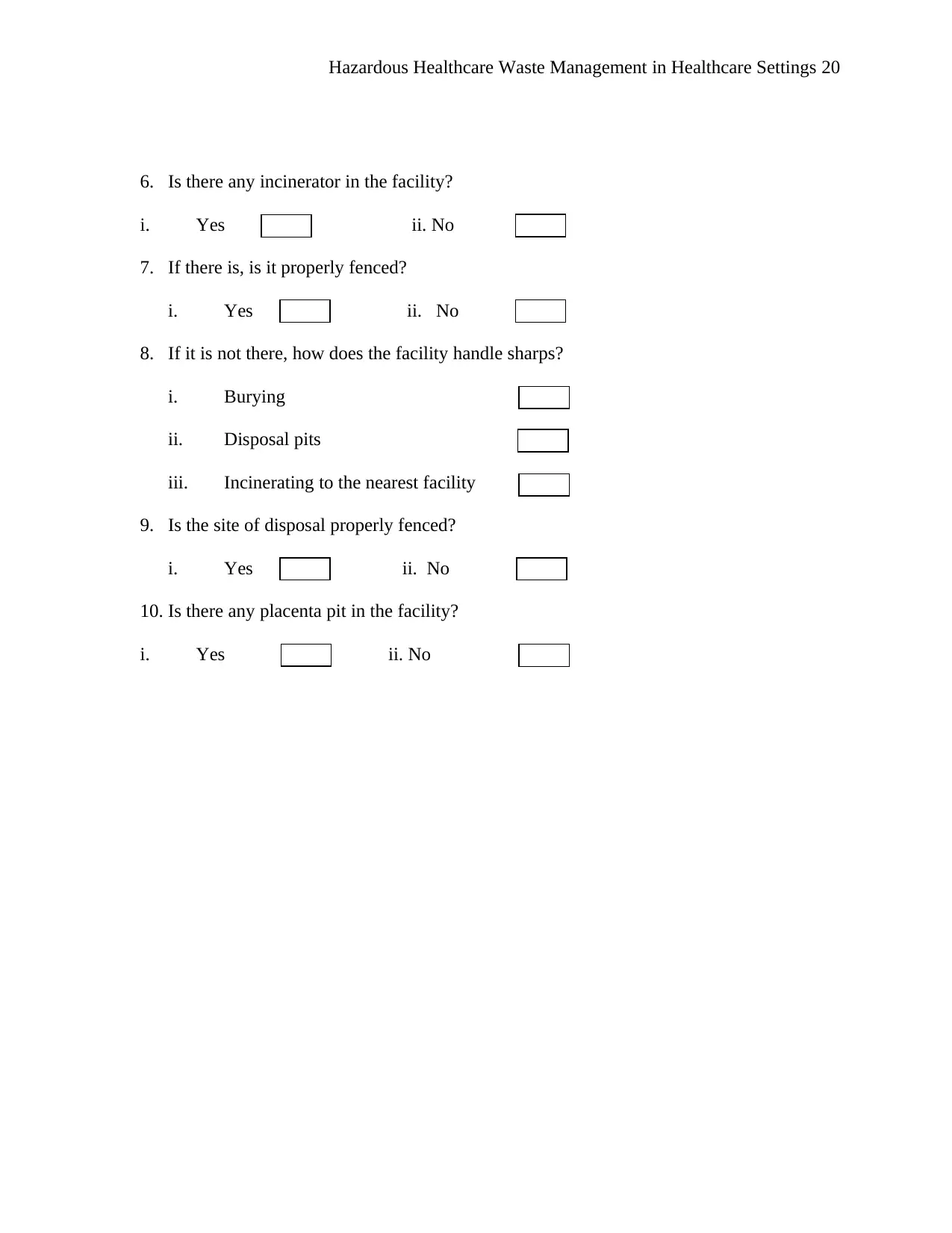
Hazardous Healthcare Waste Management in Healthcare Settings 20
6. Is there any incinerator in the facility?
i. Yes ii. No
7. If there is, is it properly fenced?
i. Yes ii. No
8. If it is not there, how does the facility handle sharps?
i. Burying
ii. Disposal pits
iii. Incinerating to the nearest facility
9. Is the site of disposal properly fenced?
i. Yes ii. No
10. Is there any placenta pit in the facility?
i. Yes ii. No
6. Is there any incinerator in the facility?
i. Yes ii. No
7. If there is, is it properly fenced?
i. Yes ii. No
8. If it is not there, how does the facility handle sharps?
i. Burying
ii. Disposal pits
iii. Incinerating to the nearest facility
9. Is the site of disposal properly fenced?
i. Yes ii. No
10. Is there any placenta pit in the facility?
i. Yes ii. No
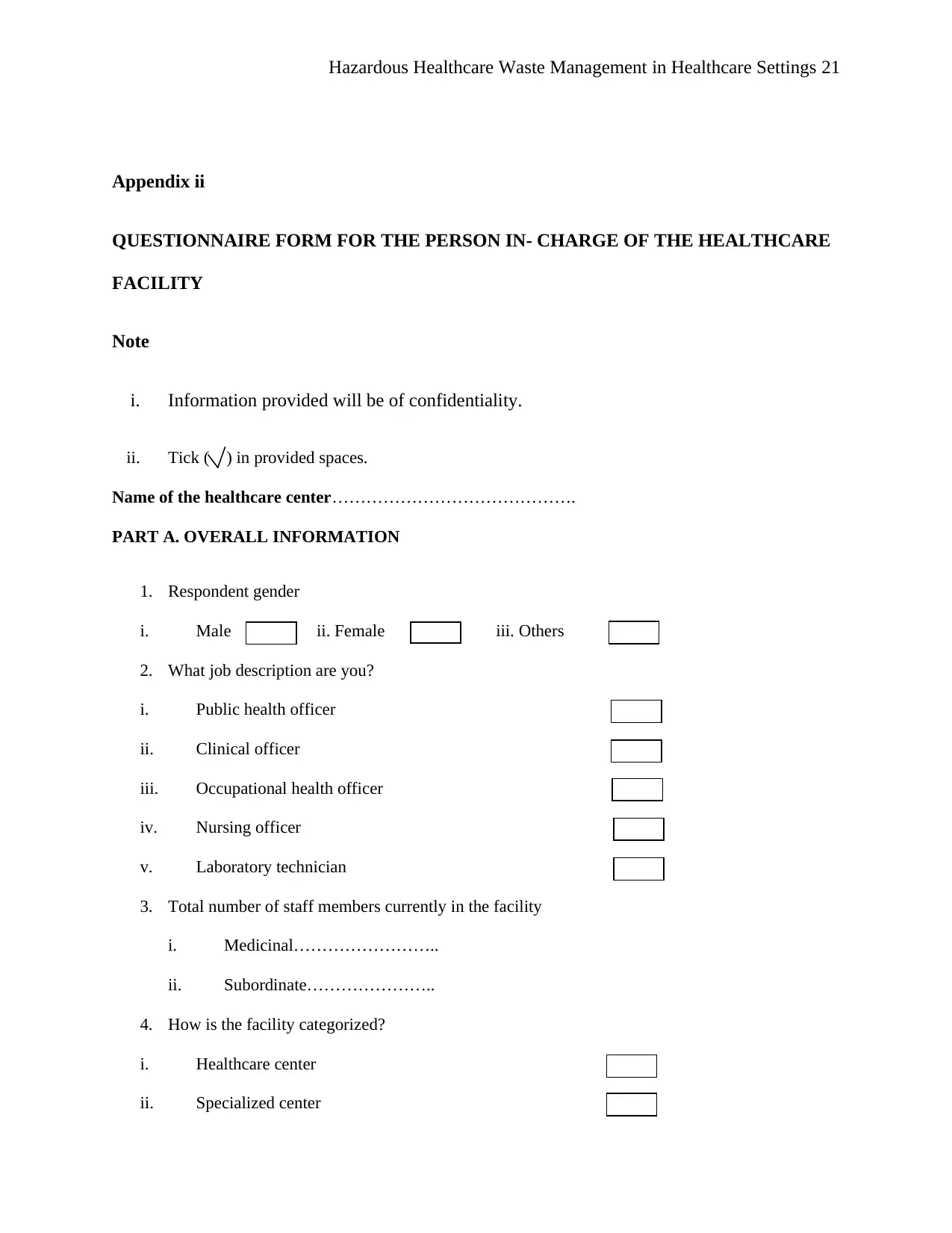
Hazardous Healthcare Waste Management in Healthcare Settings 21
Appendix ii
QUESTIONNAIRE FORM FOR THE PERSON IN- CHARGE OF THE HEALTHCARE
FACILITY
Note
i. Information provided will be of confidentiality.
ii. Tick ( ) in provided spaces.
Name of the healthcare center…………………………………….
PART A. OVERALL INFORMATION
1. Respondent gender
i. Male ii. Female iii. Others
2. What job description are you?
i. Public health officer
ii. Clinical officer
iii. Occupational health officer
iv. Nursing officer
v. Laboratory technician
3. Total number of staff members currently in the facility
i. Medicinal……………………..
ii. Subordinate…………………..
4. How is the facility categorized?
i. Healthcare center
ii. Specialized center
Appendix ii
QUESTIONNAIRE FORM FOR THE PERSON IN- CHARGE OF THE HEALTHCARE
FACILITY
Note
i. Information provided will be of confidentiality.
ii. Tick ( ) in provided spaces.
Name of the healthcare center…………………………………….
PART A. OVERALL INFORMATION
1. Respondent gender
i. Male ii. Female iii. Others
2. What job description are you?
i. Public health officer
ii. Clinical officer
iii. Occupational health officer
iv. Nursing officer
v. Laboratory technician
3. Total number of staff members currently in the facility
i. Medicinal……………………..
ii. Subordinate…………………..
4. How is the facility categorized?
i. Healthcare center
ii. Specialized center
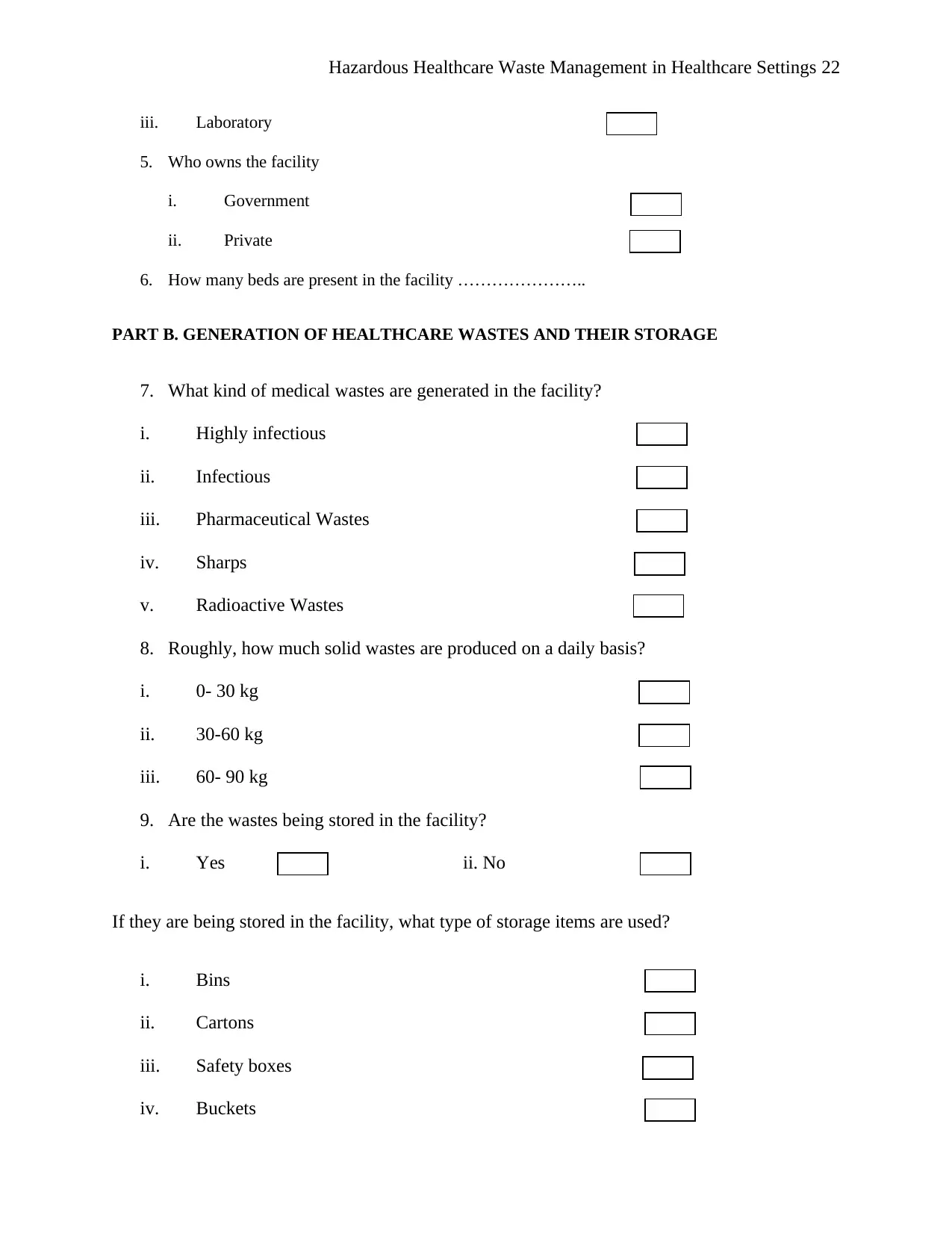
Hazardous Healthcare Waste Management in Healthcare Settings 22
iii. Laboratory
5. Who owns the facility
i. Government
ii. Private
6. How many beds are present in the facility …………………..
PART B. GENERATION OF HEALTHCARE WASTES AND THEIR STORAGE
7. What kind of medical wastes are generated in the facility?
i. Highly infectious
ii. Infectious
iii. Pharmaceutical Wastes
iv. Sharps
v. Radioactive Wastes
8. Roughly, how much solid wastes are produced on a daily basis?
i. 0- 30 kg
ii. 30-60 kg
iii. 60- 90 kg
9. Are the wastes being stored in the facility?
i. Yes ii. No
If they are being stored in the facility, what type of storage items are used?
i. Bins
ii. Cartons
iii. Safety boxes
iv. Buckets
iii. Laboratory
5. Who owns the facility
i. Government
ii. Private
6. How many beds are present in the facility …………………..
PART B. GENERATION OF HEALTHCARE WASTES AND THEIR STORAGE
7. What kind of medical wastes are generated in the facility?
i. Highly infectious
ii. Infectious
iii. Pharmaceutical Wastes
iv. Sharps
v. Radioactive Wastes
8. Roughly, how much solid wastes are produced on a daily basis?
i. 0- 30 kg
ii. 30-60 kg
iii. 60- 90 kg
9. Are the wastes being stored in the facility?
i. Yes ii. No
If they are being stored in the facility, what type of storage items are used?
i. Bins
ii. Cartons
iii. Safety boxes
iv. Buckets
Secure Best Marks with AI Grader
Need help grading? Try our AI Grader for instant feedback on your assignments.
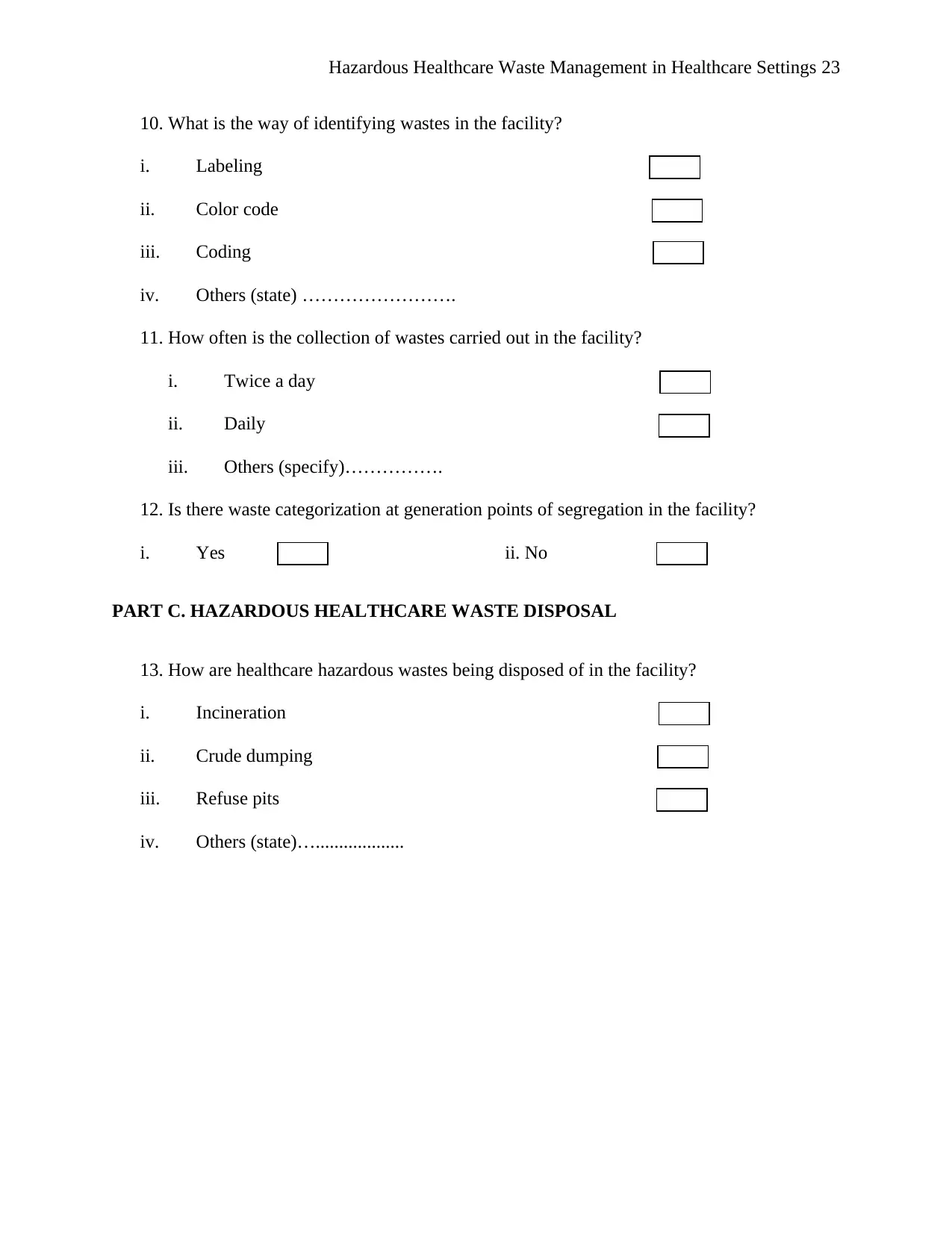
Hazardous Healthcare Waste Management in Healthcare Settings 23
10. What is the way of identifying wastes in the facility?
i. Labeling
ii. Color code
iii. Coding
iv. Others (state) …………………….
11. How often is the collection of wastes carried out in the facility?
i. Twice a day
ii. Daily
iii. Others (specify)…………….
12. Is there waste categorization at generation points of segregation in the facility?
i. Yes ii. No
PART C. HAZARDOUS HEALTHCARE WASTE DISPOSAL
13. How are healthcare hazardous wastes being disposed of in the facility?
i. Incineration
ii. Crude dumping
iii. Refuse pits
iv. Others (state)…...................
10. What is the way of identifying wastes in the facility?
i. Labeling
ii. Color code
iii. Coding
iv. Others (state) …………………….
11. How often is the collection of wastes carried out in the facility?
i. Twice a day
ii. Daily
iii. Others (specify)…………….
12. Is there waste categorization at generation points of segregation in the facility?
i. Yes ii. No
PART C. HAZARDOUS HEALTHCARE WASTE DISPOSAL
13. How are healthcare hazardous wastes being disposed of in the facility?
i. Incineration
ii. Crude dumping
iii. Refuse pits
iv. Others (state)…...................
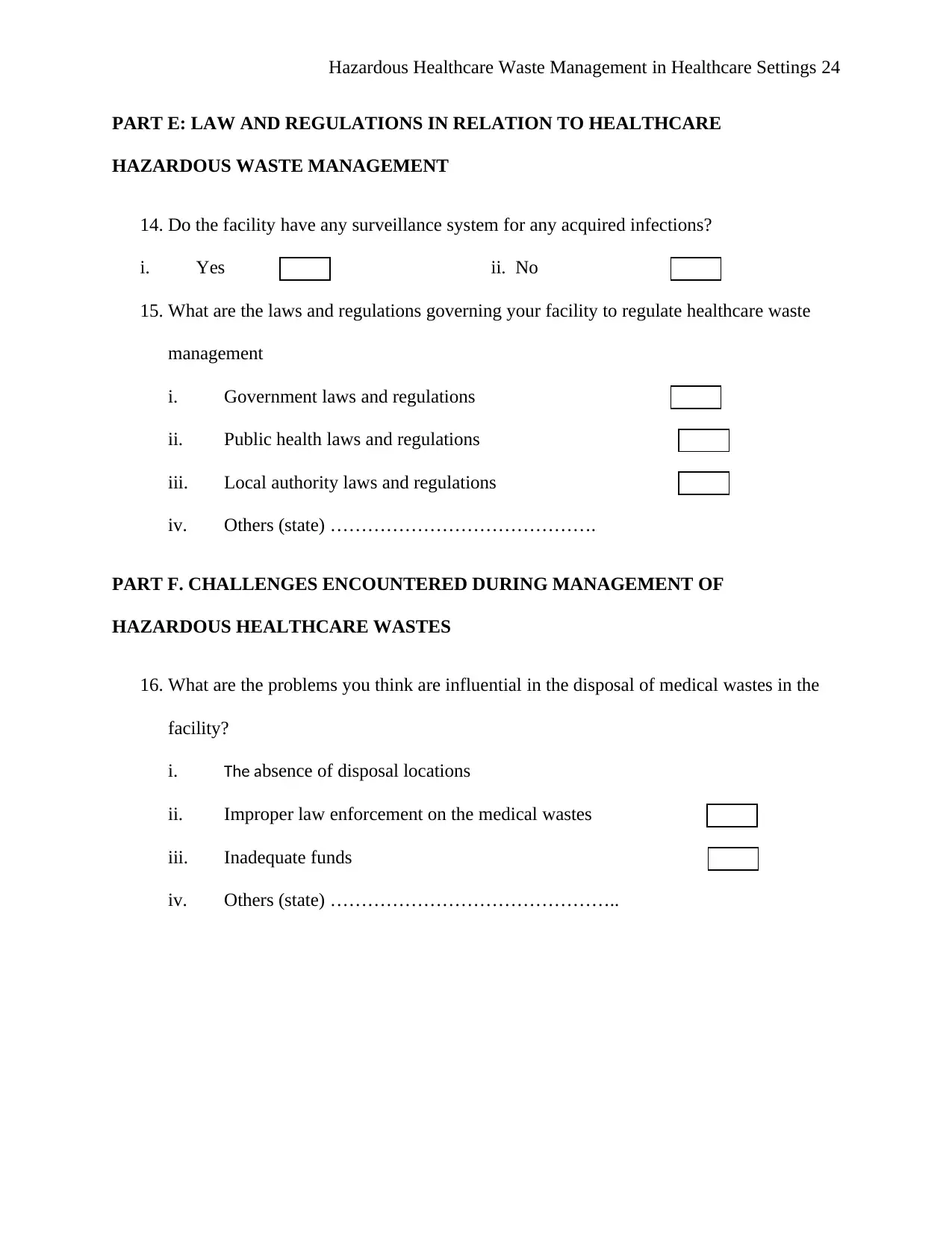
Hazardous Healthcare Waste Management in Healthcare Settings 24
PART E: LAW AND REGULATIONS IN RELATION TO HEALTHCARE
HAZARDOUS WASTE MANAGEMENT
14. Do the facility have any surveillance system for any acquired infections?
i. Yes ii. No
15. What are the laws and regulations governing your facility to regulate healthcare waste
management
i. Government laws and regulations
ii. Public health laws and regulations
iii. Local authority laws and regulations
iv. Others (state) …………………………………….
PART F. CHALLENGES ENCOUNTERED DURING MANAGEMENT OF
HAZARDOUS HEALTHCARE WASTES
16. What are the problems you think are influential in the disposal of medical wastes in the
facility?
i. The absence of disposal locations
ii. Improper law enforcement on the medical wastes
iii. Inadequate funds
iv. Others (state) ………………………………………..
PART E: LAW AND REGULATIONS IN RELATION TO HEALTHCARE
HAZARDOUS WASTE MANAGEMENT
14. Do the facility have any surveillance system for any acquired infections?
i. Yes ii. No
15. What are the laws and regulations governing your facility to regulate healthcare waste
management
i. Government laws and regulations
ii. Public health laws and regulations
iii. Local authority laws and regulations
iv. Others (state) …………………………………….
PART F. CHALLENGES ENCOUNTERED DURING MANAGEMENT OF
HAZARDOUS HEALTHCARE WASTES
16. What are the problems you think are influential in the disposal of medical wastes in the
facility?
i. The absence of disposal locations
ii. Improper law enforcement on the medical wastes
iii. Inadequate funds
iv. Others (state) ………………………………………..
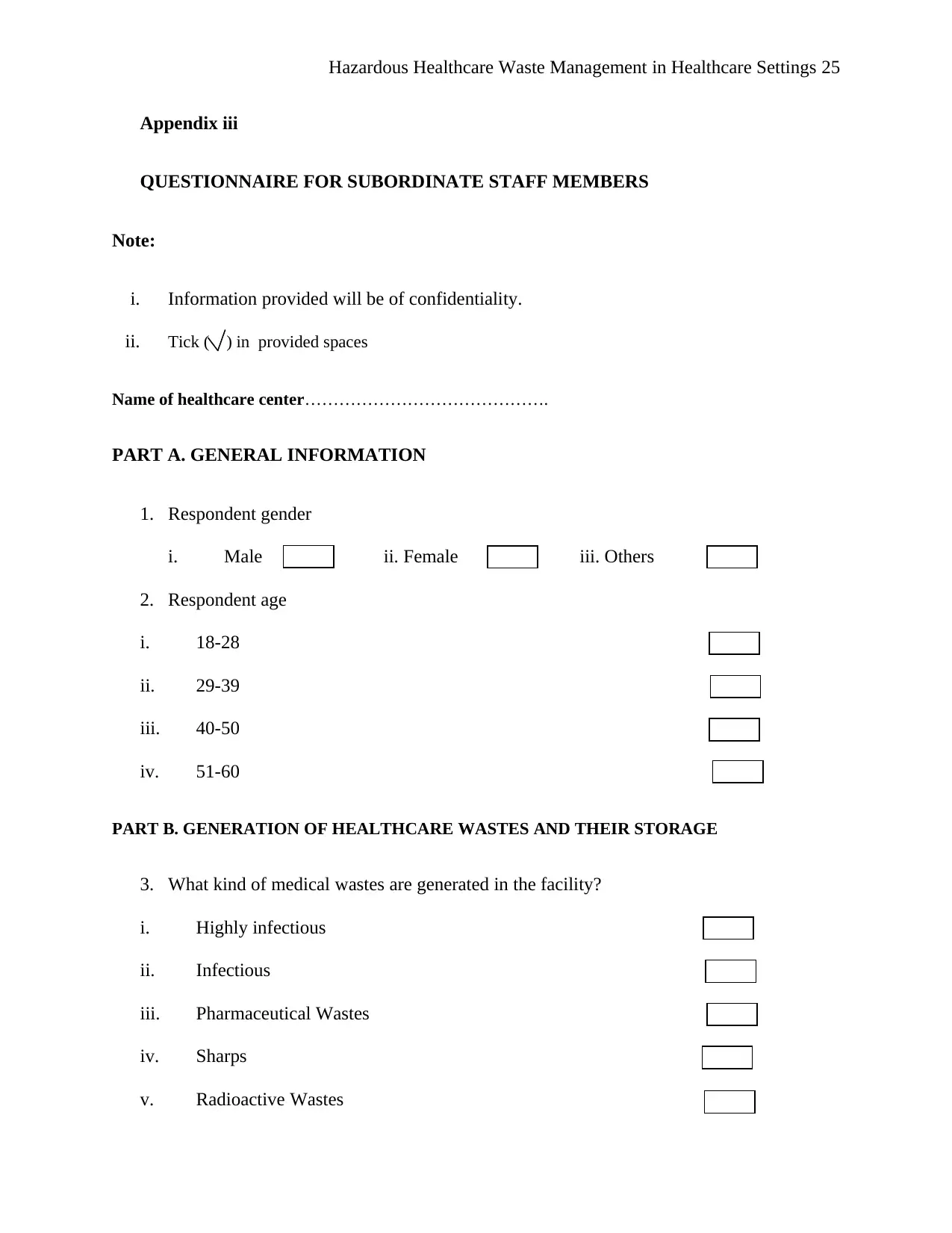
Hazardous Healthcare Waste Management in Healthcare Settings 25
Appendix iii
QUESTIONNAIRE FOR SUBORDINATE STAFF MEMBERS
Note:
i. Information provided will be of confidentiality.
ii. Tick ( ) in provided spaces
Name of healthcare center…………………………………….
PART A. GENERAL INFORMATION
1. Respondent gender
i. Male ii. Female iii. Others
2. Respondent age
i. 18-28
ii. 29-39
iii. 40-50
iv. 51-60
PART B. GENERATION OF HEALTHCARE WASTES AND THEIR STORAGE
3. What kind of medical wastes are generated in the facility?
i. Highly infectious
ii. Infectious
iii. Pharmaceutical Wastes
iv. Sharps
v. Radioactive Wastes
Appendix iii
QUESTIONNAIRE FOR SUBORDINATE STAFF MEMBERS
Note:
i. Information provided will be of confidentiality.
ii. Tick ( ) in provided spaces
Name of healthcare center…………………………………….
PART A. GENERAL INFORMATION
1. Respondent gender
i. Male ii. Female iii. Others
2. Respondent age
i. 18-28
ii. 29-39
iii. 40-50
iv. 51-60
PART B. GENERATION OF HEALTHCARE WASTES AND THEIR STORAGE
3. What kind of medical wastes are generated in the facility?
i. Highly infectious
ii. Infectious
iii. Pharmaceutical Wastes
iv. Sharps
v. Radioactive Wastes
Paraphrase This Document
Need a fresh take? Get an instant paraphrase of this document with our AI Paraphraser
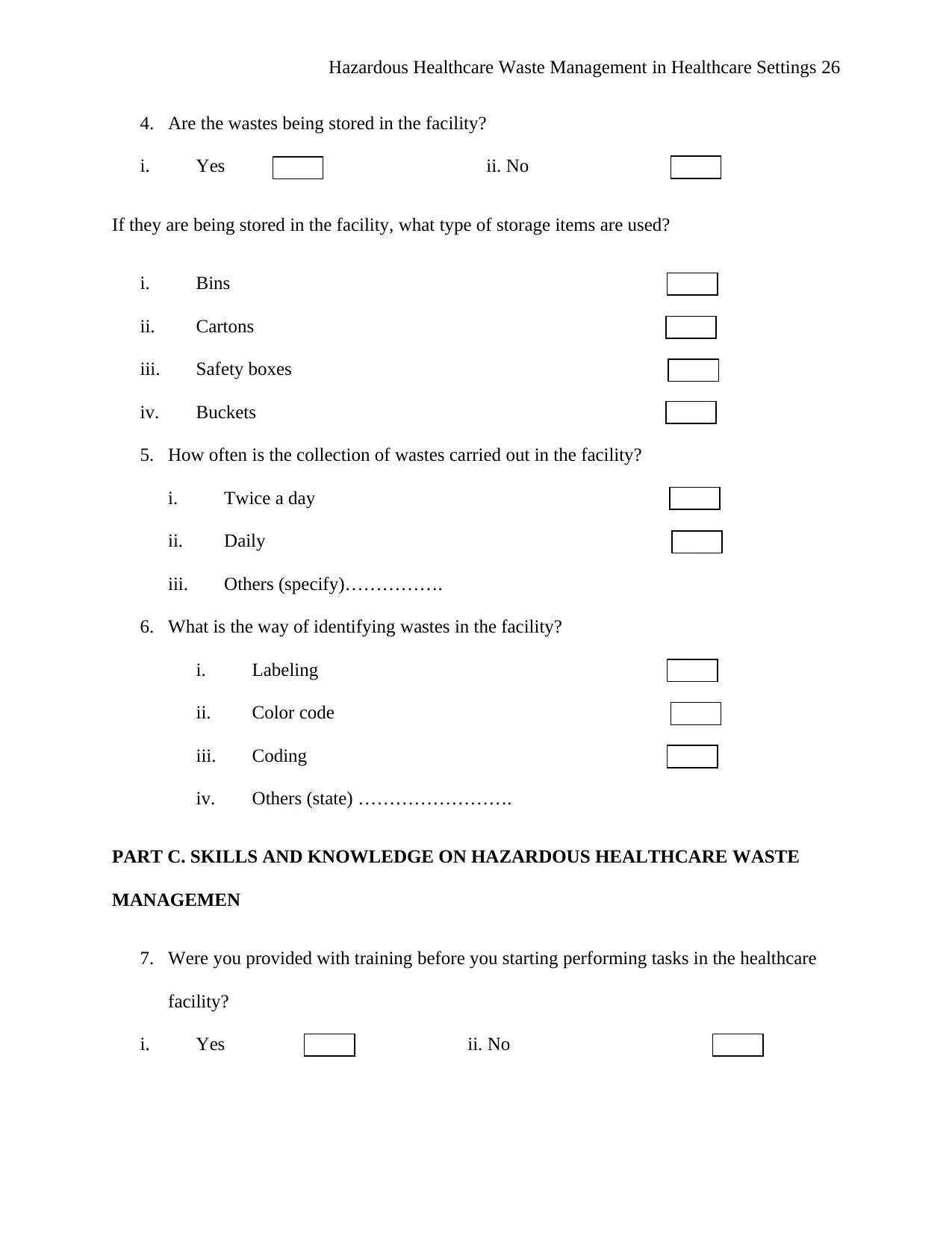
Hazardous Healthcare Waste Management in Healthcare Settings 26
4. Are the wastes being stored in the facility?
i. Yes ii. No
If they are being stored in the facility, what type of storage items are used?
i. Bins
ii. Cartons
iii. Safety boxes
iv. Buckets
5. How often is the collection of wastes carried out in the facility?
i. Twice a day
ii. Daily
iii. Others (specify)…………….
6. What is the way of identifying wastes in the facility?
i. Labeling
ii. Color code
iii. Coding
iv. Others (state) …………………….
PART C. SKILLS AND KNOWLEDGE ON HAZARDOUS HEALTHCARE WASTE
MANAGEMEN
7. Were you provided with training before you starting performing tasks in the healthcare
facility?
i. Yes ii. No
4. Are the wastes being stored in the facility?
i. Yes ii. No
If they are being stored in the facility, what type of storage items are used?
i. Bins
ii. Cartons
iii. Safety boxes
iv. Buckets
5. How often is the collection of wastes carried out in the facility?
i. Twice a day
ii. Daily
iii. Others (specify)…………….
6. What is the way of identifying wastes in the facility?
i. Labeling
ii. Color code
iii. Coding
iv. Others (state) …………………….
PART C. SKILLS AND KNOWLEDGE ON HAZARDOUS HEALTHCARE WASTE
MANAGEMEN
7. Were you provided with training before you starting performing tasks in the healthcare
facility?
i. Yes ii. No
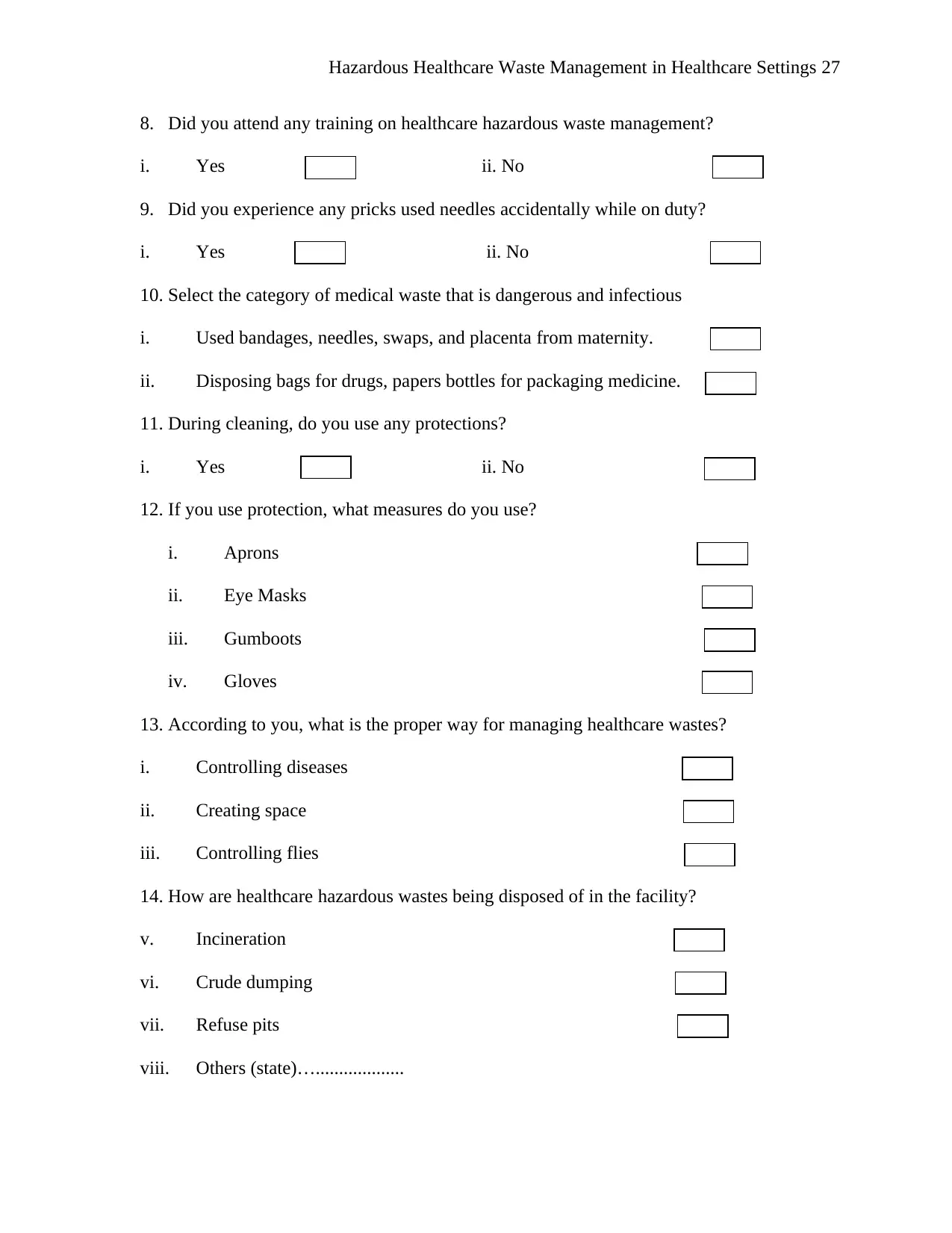
Hazardous Healthcare Waste Management in Healthcare Settings 27
8. Did you attend any training on healthcare hazardous waste management?
i. Yes ii. No
9. Did you experience any pricks used needles accidentally while on duty?
i. Yes ii. No
10. Select the category of medical waste that is dangerous and infectious
i. Used bandages, needles, swaps, and placenta from maternity.
ii. Disposing bags for drugs, papers bottles for packaging medicine.
11. During cleaning, do you use any protections?
i. Yes ii. No
12. If you use protection, what measures do you use?
i. Aprons
ii. Eye Masks
iii. Gumboots
iv. Gloves
13. According to you, what is the proper way for managing healthcare wastes?
i. Controlling diseases
ii. Creating space
iii. Controlling flies
14. How are healthcare hazardous wastes being disposed of in the facility?
v. Incineration
vi. Crude dumping
vii. Refuse pits
viii. Others (state)…...................
8. Did you attend any training on healthcare hazardous waste management?
i. Yes ii. No
9. Did you experience any pricks used needles accidentally while on duty?
i. Yes ii. No
10. Select the category of medical waste that is dangerous and infectious
i. Used bandages, needles, swaps, and placenta from maternity.
ii. Disposing bags for drugs, papers bottles for packaging medicine.
11. During cleaning, do you use any protections?
i. Yes ii. No
12. If you use protection, what measures do you use?
i. Aprons
ii. Eye Masks
iii. Gumboots
iv. Gloves
13. According to you, what is the proper way for managing healthcare wastes?
i. Controlling diseases
ii. Creating space
iii. Controlling flies
14. How are healthcare hazardous wastes being disposed of in the facility?
v. Incineration
vi. Crude dumping
vii. Refuse pits
viii. Others (state)…...................
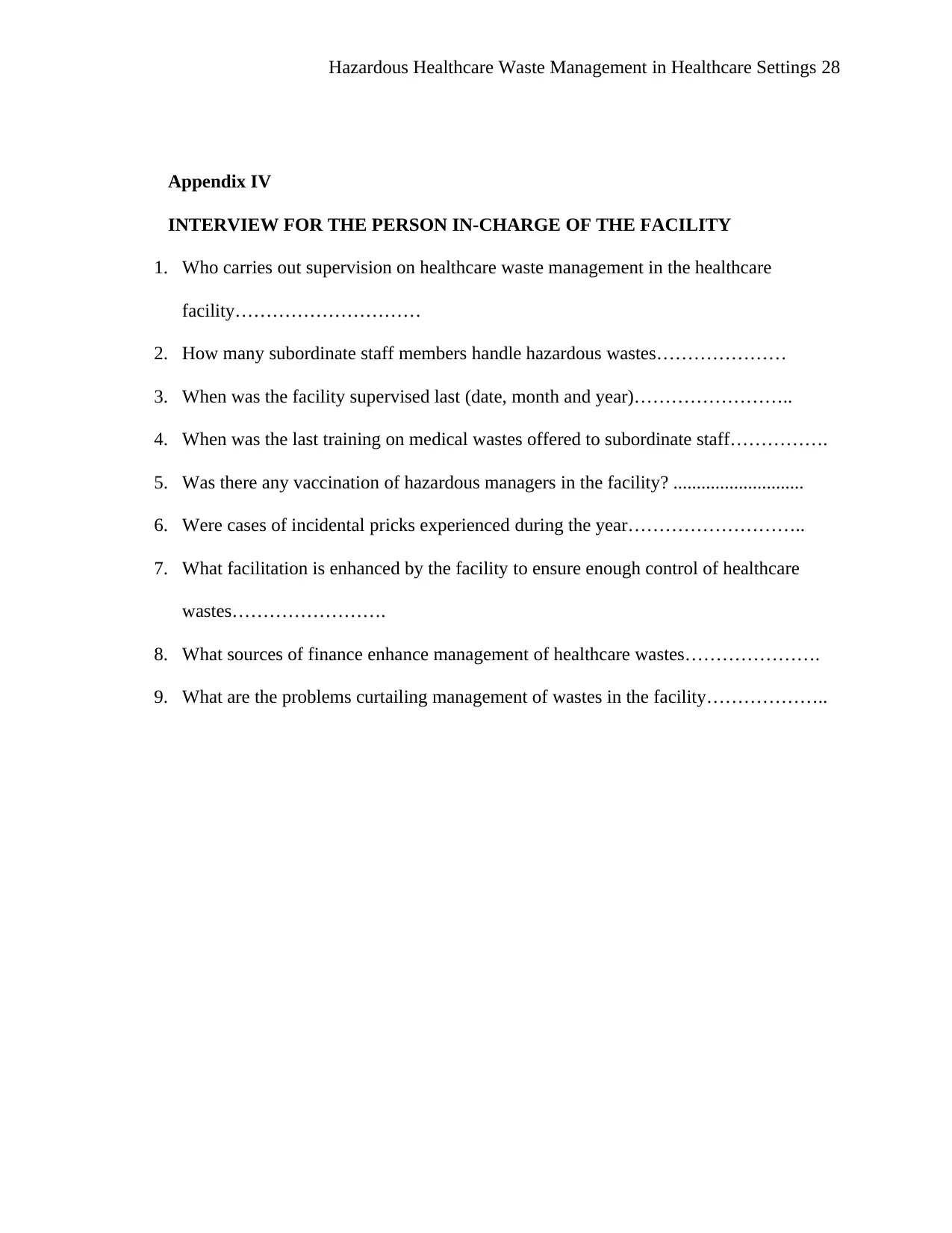
Hazardous Healthcare Waste Management in Healthcare Settings 28
Appendix IV
INTERVIEW FOR THE PERSON IN-CHARGE OF THE FACILITY
1. Who carries out supervision on healthcare waste management in the healthcare
facility…………………………
2. How many subordinate staff members handle hazardous wastes…………………
3. When was the facility supervised last (date, month and year)……………………..
4. When was the last training on medical wastes offered to subordinate staff…………….
5. Was there any vaccination of hazardous managers in the facility? ............................
6. Were cases of incidental pricks experienced during the year………………………..
7. What facilitation is enhanced by the facility to ensure enough control of healthcare
wastes…………………….
8. What sources of finance enhance management of healthcare wastes………………….
9. What are the problems curtailing management of wastes in the facility………………..
Appendix IV
INTERVIEW FOR THE PERSON IN-CHARGE OF THE FACILITY
1. Who carries out supervision on healthcare waste management in the healthcare
facility…………………………
2. How many subordinate staff members handle hazardous wastes…………………
3. When was the facility supervised last (date, month and year)……………………..
4. When was the last training on medical wastes offered to subordinate staff…………….
5. Was there any vaccination of hazardous managers in the facility? ............................
6. Were cases of incidental pricks experienced during the year………………………..
7. What facilitation is enhanced by the facility to ensure enough control of healthcare
wastes…………………….
8. What sources of finance enhance management of healthcare wastes………………….
9. What are the problems curtailing management of wastes in the facility………………..
1 out of 28
Related Documents
Your All-in-One AI-Powered Toolkit for Academic Success.
+13062052269
info@desklib.com
Available 24*7 on WhatsApp / Email
![[object Object]](/_next/static/media/star-bottom.7253800d.svg)
Unlock your academic potential
© 2024 | Zucol Services PVT LTD | All rights reserved.




